Taiwan
Taiwan,[upper-roman 2] officially the Republic of China (Taiwan)[15][16],[upper-roman 1] is a state in East Asia.[17][18] Neighbouring states include the People's Republic of China (PRC) to the north-west, Japan to the north-east, and the Philippines to the south. The island of Taiwan has an area of 35,808 square kilometers (13,826 sq mi), with mountain ranges dominating the eastern two-thirds and plains in the western third, where its highly urbanised population is concentrated. Taipei is the capital and largest metropolitan area. Other major cities include Kaohsiung, Taichung, Tainan and Taoyuan. With 23.7 million inhabitants, Taiwan is among the most densely populated states, and is the most populous state and largest economy that is not a member of the United Nations (UN).
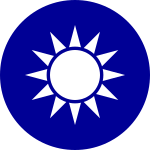 National Emblem
| |
Anthem: 中華民國國歌 Zhōnghuá Mínguó guógē ("National Anthem of the Republic of China") Flag anthem: 中華民國國旗歌 Zhōnghuá Míngúo Gúoqígē ("National Flag Anthem of the Republic of China") | |
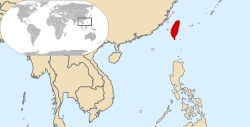 Territory controlled by the Republic of China | |
| Capital | Taipei[3] 25°04′N 121°31′E |
| National languages[lower-alpha 1] |
|
| Ethnic groups | >95% Han Chinese (Holo, Hakka, etc.) 2% Malayo-Polynesian 2% other[7] |
| Religion |
|
| Demonym(s) | Taiwanese[8] |
| Government | Unitary semi-presidential republic |
| Tsai Ing-wen | |
• Vice President | Chen Chien-jen |
• Premier | Su Tseng-chang |
• Vice Premier | Chen Chi-mai |
| Legislature | Legislative Yuan |
| Formation | |
| 1 January 1912 | |
• Taiwan transferred | 25 October 1945 |
• Constitution adopted | 25 December 1947 |
• Government moved to Taipei | 7 December 1949 |
• Status defined by law | 16 July 1992 |
| Area | |
• Total | 36,197 km2 (13,976 sq mi)[7][8] |
| Population | |
• 2018 estimate | 23,780,452[9] (53rd) |
• 2010 census | 23,123,866[10] (53rd) |
• Density | 650/km2 (1,683.5/sq mi) (17th) |
| GDP (PPP) | 2019 estimate |
• Total | |
• Per capita | |
| GDP (nominal) | 2019 estimate |
• Total | |
• Per capita | |
| Gini (2017) | medium |
| HDI (2018) | very high |
| Currency | New Taiwan dollar (NT$) (TWD) |
| Time zone | UTC+8 (National Standard Time) |
| Date format |
|
| Mains electricity | 110 V–60 Hz[lower-alpha 3] |
| Driving side | right |
| Calling code | +886 |
| ISO 3166 code | TW |
| Internet TLD |
|
Taiwanese indigenous peoples settled the island of Taiwan around 6,000 years ago. In the 17th century, Dutch rule opened the island to mass Han immigration. After the brief Kingdom of Tungning in parts of the southern and western areas of the island, the island was annexed in 1683 by the Qing dynasty of China, and ceded to the Empire of Japan in 1895. Following the surrender of Japan in 1945, the Republic of China, which had overthrown and succeeded the Qing in 1911, took control of Taiwan on behalf of the World War II Allies. The resumption of the Chinese Civil War led to the loss of the mainland to the Communist Party of China and the flight of the ROC government to Taiwan in 1949. Although the ROC government continued to claim to be the legitimate representative of China, since 1950 its effective jurisdiction has been limited to Taiwan and numerous smaller islands. In the early 1960s, Taiwan entered a period of rapid economic growth and industrialisation called the "Taiwan Miracle". In the late 1980s and early 1990s, the ROC transitioned from a one-party military dictatorship to a multi-party democracy with a semi-presidential system.
Taiwan's export-oriented industrial economy is the 21st-largest in the world, with major contributions from steel, machinery, electronics and chemicals manufacturing. Taiwan is a developed country,[19][20] ranking 15th in GDP per capita. It is ranked highly in terms of political and civil liberties,[21] education, health care[22] and human development.[lower-alpha 4][23]
The political status of Taiwan remains uncertain. The ROC is no longer a member of the UN, having been replaced by the PRC in 1971. Taiwan is claimed by the PRC, which refuses diplomatic relations with countries that recognise the ROC. Taiwan maintains official ties with 14 out of 193 UN member states and the Holy See.[24][25] International organisations in which the PRC participates either refuse to grant membership to Taiwan or allow it to participate only on a non-state basis. Taiwan is a member of the World Trade Organization, Asia-Pacific Economic Cooperation and Asian Development Bank under various names. Nearby countries and countries with large economies maintain unofficial ties with Taiwan through representative offices and institutions that function as de facto embassies and consulates. Domestically, the major political division is between parties favouring eventual Chinese unification and promoting a Chinese identity contrasted with those aspiring to independence and promoting Taiwanese identity, although both sides have moderated their positions to broaden their appeal.[26][27]
Etymology
| Taiwan | |||||||||||||||||||||||||||||||||||||||||||||
|---|---|---|---|---|---|---|---|---|---|---|---|---|---|---|---|---|---|---|---|---|---|---|---|---|---|---|---|---|---|---|---|---|---|---|---|---|---|---|---|---|---|---|---|---|---|
.svg.png) "Taiwan" in Traditional Chinese characters (top) and Simplified Chinese characters (bottom) | |||||||||||||||||||||||||||||||||||||||||||||
| Chinese name | |||||||||||||||||||||||||||||||||||||||||||||
| Traditional Chinese | 臺灣 or 台灣 | ||||||||||||||||||||||||||||||||||||||||||||
| Simplified Chinese | 台湾 | ||||||||||||||||||||||||||||||||||||||||||||
| |||||||||||||||||||||||||||||||||||||||||||||
| Amis name | |||||||||||||||||||||||||||||||||||||||||||||
| Amis | Taywan | ||||||||||||||||||||||||||||||||||||||||||||
| Bunun name | |||||||||||||||||||||||||||||||||||||||||||||
| Bunun | Tai-uan | ||||||||||||||||||||||||||||||||||||||||||||
| Paiwan name | |||||||||||||||||||||||||||||||||||||||||||||
| Paiwan | Taiwan | ||||||||||||||||||||||||||||||||||||||||||||
| Republic of China | |||||||||||||||||||||||||||||||||||||||||||||||||||||||||||||||
|---|---|---|---|---|---|---|---|---|---|---|---|---|---|---|---|---|---|---|---|---|---|---|---|---|---|---|---|---|---|---|---|---|---|---|---|---|---|---|---|---|---|---|---|---|---|---|---|---|---|---|---|---|---|---|---|---|---|---|---|---|---|---|---|
| Chinese name | |||||||||||||||||||||||||||||||||||||||||||||||||||||||||||||||
| Traditional Chinese | 中華民國 | ||||||||||||||||||||||||||||||||||||||||||||||||||||||||||||||
| Postal | Chunghwa Minkuo | ||||||||||||||||||||||||||||||||||||||||||||||||||||||||||||||
| |||||||||||||||||||||||||||||||||||||||||||||||||||||||||||||||
| China | |||||||||||||||||||||||||||||||||||||||||||||||||||||||||||||||
| Traditional Chinese | 中國 | ||||||||||||||||||||||||||||||||||||||||||||||||||||||||||||||
| Literal meaning | Middle or Central State[28] | ||||||||||||||||||||||||||||||||||||||||||||||||||||||||||||||
| |||||||||||||||||||||||||||||||||||||||||||||||||||||||||||||||
| Tibetan name | |||||||||||||||||||||||||||||||||||||||||||||||||||||||||||||||
| Tibetan | ཀྲུང་ཧྭ་དམངས་གཙོའི། ་རྒྱལ་ཁབ | ||||||||||||||||||||||||||||||||||||||||||||||||||||||||||||||
| |||||||||||||||||||||||||||||||||||||||||||||||||||||||||||||||
| Zhuang name | |||||||||||||||||||||||||||||||||||||||||||||||||||||||||||||||
| Zhuang | Cunghvaz Minzgoz | ||||||||||||||||||||||||||||||||||||||||||||||||||||||||||||||
| Mongolian name | |||||||||||||||||||||||||||||||||||||||||||||||||||||||||||||||
| Mongolian Cyrillic | Дундад иргэн улс | ||||||||||||||||||||||||||||||||||||||||||||||||||||||||||||||
| Mongolian script | ᠳᠤᠮᠳᠠᠳᠤ ᠢᠷᠭᠡᠨ ᠤᠯᠤᠰ | ||||||||||||||||||||||||||||||||||||||||||||||||||||||||||||||
| |||||||||||||||||||||||||||||||||||||||||||||||||||||||||||||||
| Uyghur name | |||||||||||||||||||||||||||||||||||||||||||||||||||||||||||||||
| Uyghur | جۇڭخۇا مىنگو | ||||||||||||||||||||||||||||||||||||||||||||||||||||||||||||||
| |||||||||||||||||||||||||||||||||||||||||||||||||||||||||||||||
| Manchu name | |||||||||||||||||||||||||||||||||||||||||||||||||||||||||||||||
| Manchu script | ᡩᡠᠯᡳᠮᠪᠠᡳ ᡳᡵᡤᡝᠨ ᡤᡠᡵᡠᠨ | ||||||||||||||||||||||||||||||||||||||||||||||||||||||||||||||
| Romanization | Dulimbai irgen' Gurun | ||||||||||||||||||||||||||||||||||||||||||||||||||||||||||||||
Various names for the island of Taiwan remain in use today, each derived from explorers or rulers during a particular historical period. The name Formosa (福爾摩沙) dates from 1542, when Portuguese sailors sighted an uncharted island and noted it on their maps as Ilha Formosa ("beautiful island").[29][30] The name Formosa eventually "replaced all others in European literature"[31] and remained in common use among English speakers into the 20th century.[32]
In the early 17th century, the Dutch East India Company established a commercial post at Fort Zeelandia (modern-day Anping, Tainan) on a coastal sandbar called "Tayouan",[33] after their ethnonym for a nearby Taiwanese aboriginal tribe, possibly Taivoan people, written by the Dutch and Portuguese variously as Taiouwang, Tayowan, Teijoan, etc.[34] This name was also adopted into the Chinese vernacular (in particular, Hokkien, as Pe̍h-ōe-jī: Tāi-oân/Tâi-oân) as the name of the sandbar and nearby area (Tainan). The modern word "Taiwan" is derived from this usage, which is seen in various forms (大員, 大圓, 大灣, 臺員, 臺圓 and 臺窩灣) in Chinese historical records. The area occupied by modern-day Tainan represented the first permanent settlement by both European colonists and Chinese immigrants. The settlement grew to be the island's most important trading centre and served as its capital until 1887.
Use of the current Chinese name (臺灣/台灣) became official as early as 1684 with the establishment of Taiwan Prefecture. Through its rapid development the entire Formosan mainland eventually became known as "Taiwan".[35][36][37][38]
In his Daoyi Zhilüe (1349), Wang Dayuan used "Liuqiu" as a name for the island of Taiwan, or the part of it closest to Penghu.[39] Elsewhere, the name was used for the Ryukyu Islands in general or Okinawa, the largest of them; indeed the name Ryūkyū is the Japanese form of Liúqiú. The name also appears in the Book of Sui (636) and other early works, but scholars cannot agree on whether these references are to the Ryukyus, Taiwan or even Luzon.[40]
The official name of the state is the "Republic of China"; it has also been known under various names throughout its existence. Shortly after the ROC's establishment in 1912, while it was still located on the Chinese mainland, the government used the short form "China" (Zhōngguó (中國)) to refer to itself, which derives from zhōng ("central" or "middle") and guó ("state, nation-state"),[lower-alpha 5] a term which also developed under the Zhou dynasty in reference to its royal demesne,[lower-alpha 6] and the name was then applied to the area around Luoyi (present-day Luoyang) during the Eastern Zhou and then to China's Central Plain before being used as an occasional synonym for the state during the Qing era.[42]
During the 1950s and 1960s, after the government had withdrawn to Taiwan upon losing the Chinese Civil War, it was commonly referred to as "Nationalist China" (or "Free China") to differentiate it from "Communist China" (or "Red China").[44]
It was a member of the United Nations representing "China" until 1971, when it lost its seat to the People's Republic of China. Over subsequent decades, the Republic of China has become commonly known as "Taiwan", after the island that comprises 99% of the territory under its control. In some contexts, especially ROC government publications, the name is written as "Republic of China (Taiwan)", "Republic of China/Taiwan", or sometimes "Taiwan (ROC)".[45]
The Republic of China participates in most international forums and organizations under the name "Chinese Taipei" due to diplomatic pressure from the People's Republic of China. For instance, it is the name under which it has competed at the Olympic Games since 1984, and its name as an observer at the World Health Organization.[46]
History
Early settlement (prehistory–1683)
.jpg)
Taiwan was joined to the mainland in the Late Pleistocene, until sea levels rose about 10,000 years ago. Fragmentary human remains dated 20,000 to 30,000 years ago have been found on the island, as well as later artifacts of a paleolithic culture.[47][48][49]
Around 6,000 years ago, Taiwan was settled by farmers, most likely from mainland China.[50] They are believed to be the ancestors of today's Taiwanese aborigines, whose languages belong to the Austronesian language family, but show much greater diversity than the rest of the family, which spans a huge area from Maritime Southeast Asia west to Madagascar and east as far as New Zealand, Hawaii and Easter Island. This has led linguists to propose Taiwan as the urheimat of the family, from which seafaring peoples dispersed across Southeast Asia and the Pacific and Indian Oceans.[51][52]
Han Chinese fishermen began settling in the Penghu islands in the 13th century.[53] Hostile tribes, and a lack of valuable trade products, meant that few outsiders visited the main island until the 16th century.[53] During the 16th century, visits to the coast by fishermen and traders from Fujian, as well as Chinese and Japanese pirates, became more frequent.[53] The Kingdom of Middag that existed from before the Portuguese and Spanish colonial period was a supra-tribal alliance located in the central western plains of Taiwan that was brutally conquered by Qing troops and collaborative indigenous communities in 1732.

The Dutch East India Company attempted to establish a trading outpost on the Penghu Islands (Pescadores) in 1622, but were driven off by Ming forces.[54] In 1624, the company established a stronghold called Fort Zeelandia on the coastal islet of Tayouan, which is now part of the main island at Anping, Tainan.[38] When the Dutch arrived, they found southwestern Taiwan already frequented by a mostly-transient Chinese population numbering close to 1,500.[55] David Wright, a Scottish agent of the company who lived on the island in the 1650s, described the lowland areas of the island as being divided among 11 chiefdoms ranging in size from two settlements to 72. Some of these fell under Dutch control, while others remained independent.[38][56] The Company began to import labourers from Fujian and Penghu, many of whom settled.[54]
In 1626, the Spanish Empire landed on and occupied northern Taiwan, at the ports of Keelung and Tamsui, as a base to extend their trading. This colony lasted 16 years until 1642, when the last Spanish fortress fell to Dutch forces.
Following the fall of the Ming dynasty, Koxinga (Zheng Chenggong), a self-styled Ming loyalist, arrived on the island and captured Fort Zeelandia in 1662, expelling the Dutch Empire and military from the island. Koxinga established the Kingdom of Tungning (1662–1683), with his capital at Tainan. He and his heirs, Zheng Jing, who ruled from 1662 to 1682, and Zheng Keshuang, who ruled less than a year, continued to launch raids on the southeast coast of mainland China well into the Qing dynasty era.[54]
Qing rule (1683–1895)

In 1683, following the defeat of Koxinga's grandson by an armada led by Admiral Shi Lang of southern Fujian, the Qing dynasty formally annexed Taiwan, placing it under the jurisdiction of Fujian province. The Qing imperial government tried to reduce piracy and vagrancy in the area, issuing a series of edicts to manage immigration and respect aboriginal land rights. Immigrants mostly from southern Fujian continued to enter Taiwan. The border between taxpaying lands and what was considered "savage" lands shifted eastward, with some aborigines becoming sinicized while others retreated into the mountains. During this time, there were a number of conflicts between different ethnic groups of Han Chinese, Quanzhou Minnanese feuding with Zhangzhou and Hakkas peasants, and major clan fights between Minnans (Hoklos), Hakkas and aborigines too.
There were more than a hundred rebellions during the early Qing including the Lin Shuangwen rebellion (1786-1788). The frequency of rebellions, riots, and civil strife in Qing Taiwan is evoked by the common saying "every three years an uprising; every five years a rebellion" (三年一反、五年一亂).[57][58]
Northern Taiwan and the Penghu Islands were the scene of subsidiary campaigns in the Sino-French War (August 1884 to April 1885). The French occupied Keelung on 1 October 1884, but were repulsed from Tamsui a few days later. The French won some tactical victories but were unable to exploit them, and the Keelung Campaign ended in stalemate. The Pescadores Campaign, beginning on 31 March 1885, was a French victory, but had no long-term consequences. The French evacuated both Keelung and the Penghu archipelago after the end of the war.
In 1887, the Qing upgraded the island's administration from being the Taiwan Prefecture of Fujian Province to Fujian-Taiwan-Province, the twentieth in the empire, with its capital at Taipei. This was accompanied by a modernization drive that included building China's first railway.[59]
Japanese rule (1895–1945)
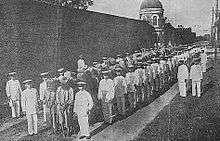
As the Qing dynasty was defeated in the First Sino-Japanese War (1894–1895), Taiwan, along with Penghu and Liaodong Peninsula, were ceded in full sovereignty to the Empire of Japan by the Treaty of Shimonoseki. Inhabitants on Taiwan and Penghu wishing to remain Qing subjects were given a two-year grace period to sell their property and move to mainland China. Very few Taiwanese saw this as feasible.[60] On 25 May 1895, a group of pro-Qing high officials proclaimed the Republic of Formosa to resist impending Japanese rule. Japanese forces entered the capital at Tainan and quelled this resistance on 21 October 1895.[61] Guerrilla fighting continued periodically until about 1902 and ultimately took the lives of 14,000 Taiwanese, or 0.5% of the population.[62] Several subsequent rebellions against the Japanese (the Beipu uprising of 1907, the Tapani incident of 1915, and the Musha incident of 1930) were all unsuccessful but demonstrated opposition to Japanese colonial rule.
Japanese colonial rule was instrumental in the industrialization of the island, extending the railways and other transport networks, building an extensive sanitation system, and establishing a formal education system in Taiwan.[63] Japanese rule ended the practice of headhunting.[64] During this period the human and natural resources of Taiwan were used to aid the development of Japan and the production of cash crops such as rice and sugar greatly increased. By 1939, Taiwan was the seventh greatest sugar producer in the world.[65] Still, the Taiwanese and aborigines were classified as second- and third-class citizens. After suppressing Chinese guerrillas in the first decade of their rule, Japanese authorities engaged in a series of bloody campaigns against the mountain aboriginals, culminating in the Musha Incident of 1930.[66] Intellectuals and labourers who participated in left-wing movements within Taiwan were also arrested and massacred (e.g. Chiang Wei-shui (蔣渭水) and Masanosuke Watanabe (渡辺政之輔)).[67]
Around 1935, the Japanese began an island-wide assimilation project to bind the island more firmly to the Japanese Empire and people were taught to see themselves as Japanese under the Kominka Movement, during which time Taiwanese culture and religion were outlawed and the citizens were encouraged to adopt Japanese surnames.[68] By 1938, 309,000 Japanese settlers resided in Taiwan.[69]
Taiwan held strategic wartime importance as Imperial Japanese military campaigns first expanded and then contracted over the course of World War II. The "South Strike Group" was based at the Taihoku Imperial University in Taipei. During World War II, tens of thousands of Taiwanese served in the Japanese military.[70] Over 2,000 women, euphemistically called "comfort women", were forced into sexual slavery for Imperial Japanese troops.[71]
The Imperial Japanese Navy operated heavily out of Taiwanese ports. In October 1944 the Formosa Air Battle was fought between American carriers and Japanese forces based in Taiwan. Important Japanese military bases and industrial centres throughout Taiwan, such as Kaohsiung and Keelung, were targets of heavy raids by American bombers.[72]
After Japan's surrender ended World War II, most of Taiwan's approximately 300,000 Japanese residents were expelled and sent to Japan.[73]
Republic of China early history (1912–1949)
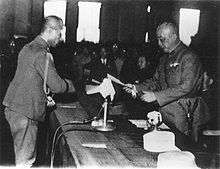
While Taiwan was still under Japanese rule, the Republic of China was founded on the mainland on 1 January 1912, following the Xinhai Revolution, which began with the Wuchang uprising on 10 October 1911, replacing the Qing dynasty and ending over two thousand years of imperial rule in China.[74] From its founding until 1949 it was based in mainland China. Central authority waxed and waned in response to warlordism (1915–28), Japanese invasion (1937–45), and the Chinese Civil War (1927–50), with central authority strongest during the Nanjing decade (1927–37), when most of China came under the control of the Kuomintang (KMT) under an authoritarian one-party state.[75]
After the Surrender of Japan on 25 October 1945, the US Navy ferried ROC troops to Taiwan to accept the formal surrender of Japanese military forces in Taipei on behalf of the Allied Powers, as part of General Order No. 1 for temporary military occupation. General Rikichi Andō, governor-general of Taiwan and commander-in-chief of all Japanese forces on the island, signed the receipt and handed it over to General Chen Yi of the ROC military to complete the official turnover. Chen Yi proclaimed that day to be "Taiwan Retrocession Day", but the Allies considered Taiwan and the Penghu Islands to be under military occupation and still under Japanese sovereignty until 1952, when the Treaty of San Francisco took effect.[76][77] Although the 1943 Cairo Declaration had envisaged returning these territories to China, it had no legal status as treaty, and also in the Treaty of San Francisco and Treaty of Taipei Japan renounced all claim to them without specifying to what country they were to be surrendered. This introduced the disputed sovereignty status of Taiwan and whether the ROC has sovereignty over Taiwan or only remaining over Kinmen and Matsu Islands.
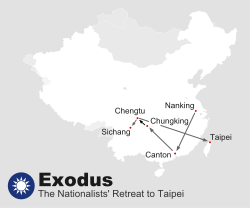
The ROC administration of Taiwan under Chen Yi was strained by increasing tensions between Taiwanese-born people and newly arrived mainlanders, which were compounded by economic woes, such as hyperinflation. Furthermore, cultural and linguistic conflicts between the two groups quickly led to the loss of popular support for the new government, while the mass movement led by the working committee of the Communist Party also aimed to bring down the Kuomintang government.[78][79] The shooting of a civilian on 28 February 1947 triggered island-wide unrest, which was suppressed with military force in what is now called the February 28 Incident. Mainstream estimates of the number killed range from 18,000 to 30,000. Those killed were mainly members of the Taiwanese elite.[80][81]
After the end of World War II, the Chinese Civil War resumed between the Chinese Nationalists (Kuomintang), led by Chiang Kai-shek, and the Communist Party of China, led by Mao Zedong. Throughout the months of 1949, a series of Chinese Communist offensives led to the capture of its capital Nanjing on 23 April and the subsequent defeat of the Nationalist army on the mainland, and the Communists founded the People's Republic of China on 1 October.[82]
On 7 December 1949, after the loss of four capitals, Chiang evacuated his Nationalist government to Taiwan and made Taipei the temporary capital of the ROC (also called the "wartime capital" by Chiang Kai-shek).[83] Some 2 million people, consisting mainly of soldiers, members of the ruling Kuomintang and intellectual and business elites, were evacuated from mainland China to Taiwan at that time, adding to the earlier population of approximately six million. In addition, the ROC government took to Taipei many national treasures and much of China's gold reserves and foreign currency reserves.[84][85][86]
After losing most of the mainland, the Kuomintang remained in control of Tibet, portions of Qinghai, Xinjiang, and Yunnan along with Hainan Island until 1951 when the Communists subsequently captured these territories too. From this point onwards, the Kuomintang's territory was reduced to the island of Taiwan, Penghu, Kinmen and Matsu Islands (Fujian Province), and two major islands of the Dongsha and Nansha island groups. The Kuomintang continued to claim sovereignty over all of "China", which it defined to include mainland China, Taiwan, Outer Mongolia and other areas. On mainland China, the victorious Communists claimed they ruled the sole and only China (which they claimed included Taiwan) and that the Republic of China no longer existed.[87]
Martial law (1949–1987)
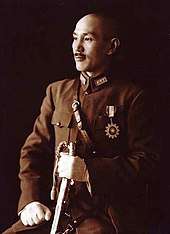
Martial law, declared on Taiwan in May 1949,[88] continued to be in effect after the central government relocated to Taiwan. It was not repealed until 1987,[88] and was used as a way to suppress the political opposition in the intervening years.[89] During the White Terror, as the period is known, 140,000 people were imprisoned or executed for being perceived as anti-KMT or pro-Communist.[90] Many citizens were arrested, tortured, imprisoned and executed for their real or perceived link to the Communists. Since these people were mainly from the intellectual and social elite, an entire generation of political and social leaders was decimated. In 1998, a law was passed to create the "Compensation Foundation for Improper Verdicts" which oversaw compensation to White Terror victims and families. President Ma Ying-jeou made an official apology in 2008, expressing hope that there would never be a tragedy similar to White Terror.[91]
Initially, the United States abandoned the KMT and expected that Taiwan would fall to the Communists. However, in 1950 the conflict between North Korea and South Korea, which had been ongoing since the Japanese withdrawal in 1945, escalated into full-blown war, and in the context of the Cold War, US President Harry S. Truman intervened again and dispatched the US Navy's 7th Fleet into the Taiwan Strait to prevent hostilities between Taiwan and mainland China.[92] In the Treaty of San Francisco and the Treaty of Taipei, which came into force respectively on 28 April 1952 and 5 August 1952, Japan formally renounced all right, claim and title to Taiwan and Penghu, and renounced all treaties signed with China before 1942. Neither treaty specified to whom sovereignty over the islands should be transferred, because the United States and the United Kingdom disagreed on whether the ROC or the PRC was the legitimate government of China.[93] Continuing conflict of the Chinese Civil War through the 1950s, and intervention by the United States notably resulted in legislation such as the Sino-American Mutual Defense Treaty and the Formosa Resolution of 1955.
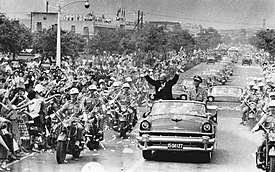
As the Chinese Civil War continued without truce, the government built up military fortifications throughout Taiwan. Within this effort, KMT veterans built the now famous Central Cross-Island Highway through the Taroko Gorge in the 1950s. The two sides would continue to engage in sporadic military clashes with seldom publicized details well into the 1960s on the China coastal islands with an unknown number of night raids. During the Second Taiwan Strait Crisis in September 1958, Taiwan's landscape saw Nike-Hercules missile batteries added, with the formation of the 1st Missile Battalion Chinese Army that would not be deactivated until 1997. Newer generations of missile batteries have since replaced the Nike Hercules systems throughout the island.
During the 1960s and 1970s, the ROC maintained an authoritarian, single-party government while its economy became industrialized and technology-oriented. This rapid economic growth, known as the Taiwan Miracle, was the result of a fiscal regime independent from mainland China and backed up, among others, by the support of US funds and demand for Taiwanese products.[94][95] In the 1970s, Taiwan was economically the second fastest growing state in Asia after Japan.[96] Taiwan, along with Hong Kong, South Korea and Singapore, became known as one of the Four Asian Tigers. Because of the Cold War, most Western nations and the United Nations regarded the ROC as the sole legitimate government of China until the 1970s. Later, especially after the termination of the Sino-American Mutual Defense Treaty, most nations switched diplomatic recognition to the PRC (see United Nations General Assembly Resolution 2758).
Until the 1970s the government was regarded by Western critics as undemocratic for upholding martial law, for severely repressing any political opposition, and for controlling media. The KMT did not allow the creation of new parties and those that existed did not seriously compete with the KMT. Thus, competitive democratic elections did not exist.[97][98][99][100][101] From the late 1970s to the 1990s, however, Taiwan went through reforms and social changes that transformed it from an authoritarian state to a democracy. In 1979, a pro-democracy protest known as the Kaohsiung Incident took place in Kaohsiung to celebrate Human Rights Day. Although the protest was rapidly crushed by the authorities, it is today considered as the main event that united Taiwan's opposition.[102]
Chiang Ching-kuo, Chiang Kai-shek's son and successor as the president, began reforms to the political system in the mid-1980s. In 1984, the younger Chiang selected Lee Teng-hui, a Taiwanese-born, US-educated technocrat, to be his vice-president. In 1986, the Democratic Progressive Party (DPP) was formed and inaugurated as the first opposition party in the ROC to counter the KMT. A year later, Chiang Ching-kuo lifted martial law on the main island of Taiwan (martial law was lifted on Penghu in 1979, Matsu island in 1992 and Kinmen island in 1993). With the advent of democratization, the issue of the political status of Taiwan gradually resurfaced as a controversial issue where, previously, the discussion of anything other than unification under the ROC was taboo.
Post-martial law (1987–present)
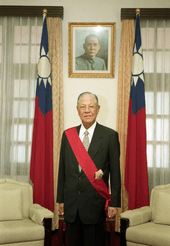
After the death of Chiang Ching-kuo in January 1988, Lee Teng-hui succeeded him and became the first Taiwan-born president. Lee continued the democratic reforms to the government and decreased the concentration of government authority in the hands of mainland Chinese. Under Lee, Taiwan underwent a process of localization in which Taiwanese culture and history were promoted over a pan-China viewpoint in contrast to earlier KMT policies which had promoted a Chinese identity. Lee's reforms included printing banknotes from the Central Bank rather than the Provincial Bank of Taiwan, and streamlining the Taiwan Provincial Government with most of its functions transferred to the Executive Yuan. Under Lee, the original members of the Legislative Yuan and National Assembly (a former supreme legislative body defunct in 2005),[103] elected in 1947 to represent mainland Chinese constituencies and having held the seats without re-election for more than four decades, were forced to resign in 1991. The previously nominal representation in the Legislative Yuan was brought to an end, reflecting the reality that the ROC had no jurisdiction over mainland China, and vice versa. Restrictions on the use of Taiwanese Hokkien in the broadcast media and in schools were also lifted.[104]
.jpg)
Reforms continued in the 1990s. The Additional Articles of the Constitution of the Republic of China and the Act Governing Relations between the People of the Taiwan Area and the Mainland Area defined the status of the ROC, making Taiwan its de facto territory. Lee Teng-hui re-elected in 1996, in the first direct presidential election in the history of the ROC.[105] During the later years of Lee's administration, he was involved in corruption controversies relating to government release of land and weapons purchase, although no legal proceedings commenced. In 1997,"To meet the requisites of the nation prior to national unification",[106] the Additional Articles of the Constitution of the Republic of China was passed and then the former "constitution of five powers" turns to be more tripartite. In 2000, Chen Shui-bian of the Democratic Progressive Party was elected as the first non-Kuomintang (KMT) President and was re-elected to serve his second and last term since 2004. Polarized politics emerged in Taiwan with the formation of the Pan-Blue Coalition, led by the KMT, and the Pan-Green Coalition, led by the DPP. The former favors eventual Chinese unification, while the latter favors Taiwanese independence.[107] In early 2006, President Chen Shui-bian remarked: "The National Unification Council will cease to function. No budget will be ear-marked for it and its personnel must return to their original posts...The National Unification Guidelines will cease to apply."[108]
.jpg)
On 30 September 2007, the ruling DPP approved a resolution asserting a separate identity from China and called for the enactment of a new constitution for a "normal country". It also called for general use of "Taiwan" as the country's name, without abolishing its formal name, the Republic of China.[109] The Chen administration also pushed for referendums on cross-Strait relations in 2004 and UN entry in 2008, both of which held on the same day as the presidential election. They both failed due to voter turnout below the required legal threshold of 50% of all registered voters.[110] The Chen administration was dogged by public concerns over reduced economic growth, legislative gridlock due to a pan-blue, opposition-controlled Legislative Yuan and corruption involving the First Family as well as government officials.[111][112]
The KMT increased its majority in the Legislative Yuan in the January 2008 legislative elections, while its nominee Ma Ying-jeou went on to win the presidency in March of the same year, campaigning on a platform of increased economic growth and better ties with the PRC under a policy of "mutual nondenial".[110] Ma took office on 20 May 2008, the same day that President Chen Shui-bian stepped down and was notified by prosecutors of possible corruption charges. Part of the rationale for campaigning for closer economic ties with the PRC stems from the strong economic growth China attained since joining the World Trade Organization. However, some analysts said that despite the election of Ma Ying-jeou, the diplomatic and military tensions with the PRC had not been reduced.[113]
In 2016, Tsai Ing-wen of the Democratic Progressive Party (DPP) became President of Taiwan. President Tsai requested the international community to help Taiwan preserve its de facto independence despite the objections raised by Xi Jinping, General Secretary of the Communist Party of China (PRC paramount leader).[114] President Tsai called upon the PRC to democratize, respect human rights, and renounce the use of military force against Taiwan.[115] She was re-elected in 2020.
Geography
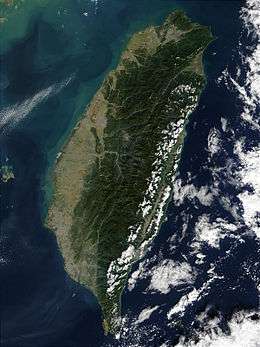
Taiwan is an island state in East Asia. The main island, known historically as Formosa, makes up 99% of the area controlled by the ROC, measuring 35,808 square kilometres (13,826 sq mi) and lying some 180 kilometres (112 mi) across the Taiwan Strait from the southeastern coast of mainland China. The East China Sea lies to its north, the Philippine Sea to its east, the Luzon Strait directly to its south and the South China Sea to its southwest. Smaller islands include a number in the Taiwan Strait including the Penghu archipelago, the Kinmen and Matsu Islands near the Chinese coast, and some of the South China Sea Islands.
The main island is a tilted fault block, characterized by the contrast between the eastern two-thirds, consisting mostly of five rugged mountain ranges parallel to the east coast, and the flat to gently rolling plains of the western third, where the majority of Taiwan's population reside. There are several peaks over 3,500 m, the highest being Yu Shan at 3,952 m (12,966 ft), making Taiwan the world's fourth-highest island. The tectonic boundary that formed these ranges is still active, and the island experiences many earthquakes, a few of them highly destructive. There are also many active submarine volcanoes in the Taiwan Straits.
The eastern mountains are heavily forested and home to a diverse range of wildlife, while land use in the western and northern lowlands is intensive.
Climate
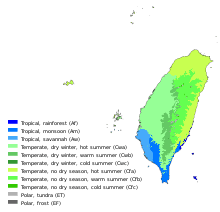
Taiwan lies on the Tropic of Cancer, and its general climate is marine tropical.[8] The northern and central regions are subtropical, whereas the south is tropical and the mountainous regions are temperate.[116] The average rainfall is 2,600 millimetres (100 inches) per year for the island proper; the rainy season is concurrent with the onset of the summer East Asian Monsoon in May and June.[117] The entire island experiences hot, humid weather from June through September. Typhoons are most common in July, August and September.[117] During the winter (November to March), the northeast experiences steady rain, while the central and southern parts of the island are mostly sunny.
Geology
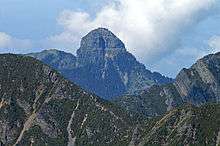
The island of Taiwan lies in a complex tectonic area between the Yangtze Plate to the west and north, the Okinawa Plate on the north-east, and the Philippine Mobile Belt on the east and south. The upper part of the crust on the island is primarily made up of a series of terranes, mostly old island arcs which have been forced together by the collision of the forerunners of the Eurasian Plate and the Philippine Sea Plate. These have been further uplifted as a result of the detachment of a portion of the Eurasian Plate as it was subducted beneath remnants of the Philippine Sea Plate, a process which left the crust under Taiwan more buoyant.[118]
The east and south of Taiwan are a complex system of belts formed by, and part of the zone of, active collision between the North Luzon Trough portion of the Luzon Volcanic Arc and South China, where accreted portions of the Luzon Arc and Luzon forearc form the eastern Coastal Range and parallel inland Longitudinal Valley of Taiwan respectively.[119]
The major seismic faults in Taiwan correspond to the various suture zones between the various terranes. These have produced major quakes throughout the history of the island. On 21 September 1999, a 7.3 quake known as the "921 earthquake" killed more than 2,400 people. The seismic hazard map for Taiwan by the USGS shows 9/10 of the island at the highest rating (most hazardous).[120]
Political and legal status
The political and legal statuses of Taiwan are contentious issues. The People's Republic of China (PRC) claims that the Republic of China government is illegitimate, referring to it as the "Taiwan Authority".[121][122] The ROC has its own constitution, independently elected president and armed forces. It has not formally renounced its claim to the mainland, but ROC government publications have increasingly downplayed it.[123]
Internationally, there is controversy on whether the ROC still exists as a state or a defunct state per international law due to the lack of wide diplomatic recognition. In a poll of Taiwanese aged 20 and older taken by TVBS in March 2009, a majority of 64% opted for the "status quo", while 19% favoured "independence" and 5% favoured "unification".[124]
Relations with the PRC
The political environment is complicated by the potential for military conflict should Taiwan declare de jure independence. It is the official PRC policy to force unification if peaceful unification is no longer possible, as stated in its anti-secession law, and for this reason there is a substantial military presence on the Fujian coast.[125][126][127][128][129]
On 29 April 2005, Kuomintang Chairman Lien Chan travelled to Beijing and met with Communist Party of China (CPC) General Secretary Hu Jintao,[130] the first meeting between the leaders of the two parties since the end of the Chinese Civil War in 1949. On 11 February 2014, Mainland Affairs Council head Wang Yu-chi travelled to Nanjing and met with Taiwan Affairs Office head Zhang Zhijun, the first meeting between high-ranking officials from either side.[131] Zhang paid a reciprocal visit to Taiwan and met Wang on 25 June 2014, making Zhang the first minister-level PRC official to ever visit Taiwan.[132] On 7 November 2015, Ma Ying-jeou (in his capacity as Leader of Taiwan) and Xi Jinping (in his capacity as leader of Mainland China[133]) travelled to Singapore and met up,[134] marking the highest-level exchange between the two sides since 1945.[135] In response to US support for Taiwan, the PRC defence ministry declared in 2019 that "If anyone dares to split Taiwan from China, the Chinese military has no choice but to fight at all costs".[136]
The PRC supports a version of the One-China policy, which states that Taiwan and mainland China are both part of China, and that the PRC is the only legitimate government of China. It uses this policy to prevent the international recognition of the ROC as an independent sovereign state, meaning that Taiwan participates in international forums under the name "Chinese Taipei". With the emergence of the Taiwanese independence movement, the name "Taiwan" has been used increasingly often on the island.[137]
President Tsai Ing-wen has supported the 2019 Hong Kong protests and expressed her solidarity with the people of Hong Kong. Pledging that as long as she is Taiwan's president, Tsai will never accept "one country, two systems".[138]
Foreign relations
.png)
Before 1928, the foreign policy of Republican China was complicated by a lack of internal unity—competing centres of power all claimed legitimacy. This situation changed after the defeat of the Peiyang Government by the Kuomintang, which led to widespread diplomatic recognition of the Republic of China.[139]
After the KMT's retreat to Taiwan, most countries, notably the countries in the Western Bloc, continued to maintain relations with the ROC. Due to diplomatic pressure, recognition gradually eroded and many countries switched recognition to the PRC in the 1970s. UN Resolution 2758 (25 October 1971) recognized the People's Republic of China as China's sole representative in the United Nations.[140]
The PRC refuses to have diplomatic relations with any nation that has diplomatic relations with the ROC, and requires all nations with which it has diplomatic relations to make a statement recognizing its claims to Taiwan.[141] As a result, only 14 UN member states and the Holy See maintain official diplomatic relations with the Republic of China.[24] The ROC maintains unofficial relations with most countries via de facto embassies and consulates called Taipei Economic and Cultural Representative Offices (TECRO), with branch offices called "Taipei Economic and Cultural Offices" (TECO). Both TECRO and TECO are "unofficial commercial entities" of the ROC in charge of maintaining diplomatic relations, providing consular services (i.e. visa applications), and serving the national interests of the ROC in other countries.[142]
The United States remains one of the main allies of Taiwan and, through the Taiwan Relations Act passed in 1979, has continued selling arms and providing military training to the Armed Forces.[143] This situation continues to be an issue for the People's Republic of China, which considers US involvement disruptive to the stability of the region. In January 2010, the Obama administration announced its intention to sell $6.4 billion worth of military hardware to Taiwan. As a consequence, the PRC threatened the US with economic sanctions and warned that their co-operation on international and regional issues could suffer.[144]
The official position of the United States is that the PRC is expected to "use no force or threat[en] to use force against Taiwan" and the ROC is to "exercise prudence in managing all aspects of Cross-Strait relations." Both are to refrain from performing actions or espousing statements "that would unilaterally alter Taiwan's status".[145]
On 16 December 2015, the Obama administration announced a deal to sell $1.83 billion worth of arms to the armed forces of the ROC.[146][147] The foreign ministry of the PRC had expressed its disapproval for the sales and issued the US a "stern warning", saying it would hurt PRC–US relations.[148]
Participation in international events and organizations
The ROC was a founding member of the United Nations, and held the seat of China on the Security Council and other UN bodies until 1971, when it was expelled by Resolution 2758 and replaced in all UN organs with the PRC. Each year since 1992, the ROC has petitioned the UN for entry, but its applications have not made it past committee stage.[149]
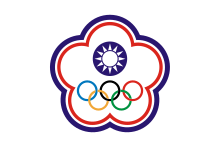
Due to its limited international recognition, the Republic of China has been a member of the Unrepresented Nations and Peoples Organization (UNPO) since the foundation of the organization in 1991, represented by a government-funded organization, the Taiwan Foundation for Democracy (TFD), under the name "Taiwan".[150][151]
Also due to its One China policy, the PRC only participates in international organizations where the ROC does not participate as a sovereign country. Most member states, including the United States, do not wish to discuss the issue of the ROC's political status for fear of souring diplomatic ties with the PRC.[152] However, both the US and Japan publicly support the ROC's bid for membership in the World Health Organization (WHO) as an observer.[153] However, though the ROC sought to participate in the WHO since 1997,[154][155] their efforts were blocked by the PRC until 2010, when they were invited as observers to attend the World Health Assembly, under the name "Chinese Taipei".[156] In 2017 Taiwan again began to be excluded from the WHO even in an observer capacity.[157] This exclusion caused a number of scandals during the COVID-19 outbreak.[158][159]
Due to PRC pressure, the ROC is forced to use the name "Chinese Taipei" in international events, such as the Olympic Games, where the PRC is also a party.[160] The ROC is typically barred from using its national anthem and national flag in international events due to PRC pressure; ROC spectators attending events such as the Olympics are often barred from bringing ROC flags into venues.[161] Taiwan also participates in the Asia-Pacific Economic Cooperation forum (since 1991) and the World Trade Organization (since 2002) under the name "Chinese Taipei". The ROC is able to participate as "China" in organizations in which the PRC does not participate, such as the World Organization of the Scout Movement.
Domestic opinion
Within Taiwan, opinions are polarized between those supporting unification, represented by the Pan-Blue Coalition of parties, and those supporting independence, represented by the Pan-Green Coalition.
The KMT, the largest Pan-Blue party, supports the status quo for the indefinite future with a stated ultimate goal of unification. However, it does not support unification in the short term with the PRC as such a prospect would be unacceptable to most of its members and the public.[162] Ma Ying-jeou, chairman of the KMT and former president of the ROC, has set out democracy, economic development to a level near that of Taiwan, and equitable wealth distribution as the conditions that the PRC must fulfill for reunification to occur.[163]
The Democratic Progressive Party, the largest Pan-Green party, officially seeks independence, but in practice also supports the status quo because its members and the public would not accept the risk of provoking the PRC.[164][165]
On 2 September 2008, Mexican newspaper El Sol de México asked President Ma about his views on the subject of "two Chinas" and if there was a solution for the sovereignty issues between the two. The president replied that the relations are neither between two Chinas nor two states. It is a special relationship. Further, he stated that the sovereignty issues between the two cannot be resolved at present, but he quoted the "1992 Consensus", currently accepted by both the Kuomintang and the Communist Party of China, as a temporary measure until a solution becomes available.[166]
On 27 September 2017, Taiwanese premier William Lai said that he was a "political worker who advocates Taiwan independence", but that as Taiwan was an independent country called the Republic of China, it had no need to declare independence.[167] The relationship with the PRC and the related issues of Taiwanese independence and Chinese unification continue to dominate politics.[168]
Government and politics
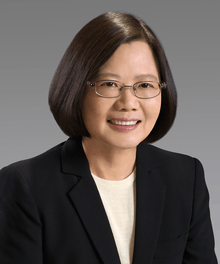 |
 |
| Tsai Ing-wen President |
Su Tseng-chang Premier |
The government of the Republic of China was founded on the Constitution of the ROC and its Three Principles of the People, which states that the ROC "shall be a democratic republic of the people, to be governed by the people and for the people".[169] The government is divided into five branches (Yuan): the Executive Yuan (cabinet), the Legislative Yuan (Congress or Parliament), the Judicial Yuan, the Control Yuan (audit agency), and the Examination Yuan (civil service examination agency). The constitution was drafted while the ROC still governed the Chinese mainland. It was created by the KMT for the purpose of all of its claimed territory, including Taiwan, even though the Communist Party boycotted the drafting of the constitution. The constitution went into effect on 25 December 1947.[170] The ROC remained under martial law from 1948 until 1987 and much of the constitution was not in effect. Political reforms beginning in the late 1970s and continuing through the early 1990s transformed into a multiparty democracy. Since the lifting of martial law, the Republic of China has democratized and reformed, suspending constitutional components that were originally meant for the whole of China. This process of amendment continues. In 2000, the Democratic Progressive Party (DPP) won the presidency, ending KMT's continuous control of the government. In May 2005, a new National Assembly was elected to reduce the number of parliamentary seats and implement several constitutional reforms. These reforms have been passed; the National Assembly has essentially voted to abolish itself and transfer the power of constitutional reform to the popular ballot.[171]
The head of state and commander-in-chief of the armed forces is the president, who is elected by popular vote for a maximum of 2 four-year terms on the same ticket as the vice-president. The president has authority over the Yuan. The president appoints the members of the Executive Yuan as his cabinet, including a premier, who is officially the President of the Executive Yuan; members are responsible for policy and administration.[169]
The main legislative body is the unicameral Legislative Yuan with 113 seats. Seventy-three are elected by popular vote from single-member constituencies; thirty-four are elected based on the proportion of nationwide votes received by participating political parties in a separate party list ballot; and six are elected from two three-member aboriginal constituencies. Members serve four-year terms. Originally the unicameral National Assembly, as a standing constitutional convention and electoral college, held some parliamentary functions, but the National Assembly was abolished in 2005 with the power of constitutional amendments handed over to the Legislative Yuan and all eligible voters of the Republic via referendums.[169]
The premier is selected by the president without the need for approval from the legislature, but the legislature can pass laws without regard for the president, as neither he nor the Premier wields veto power.[169] Thus, there is little incentive for the president and the legislature to negotiate on legislation if they are of opposing parties. After the election of the pan-Green's Chen Shui-bian as President in 2000, legislation repeatedly stalled because of deadlock with the Legislative Yuan, which was controlled by a pan-Blue majority.[172] Historically, the ROC has been dominated by strongman single party politics. This legacy has resulted in executive powers currently being concentrated in the office of the president rather than the premier, even though the constitution does not explicitly state the extent of the president's executive power.[173]
The Judicial Yuan is the highest judicial organ. It interprets the constitution and other laws and decrees, judges administrative suits, and disciplines public functionaries. The president and vice-president of the Judicial Yuan and additional thirteen justices form the Council of Grand Justices.[174] They are nominated and appointed by the president, with the consent of the Legislative Yuan. The highest court, the Supreme Court, consists of a number of civil and criminal divisions, each of which is formed by a presiding judge and four associate judges, all appointed for life. In 1993, a separate constitutional court was established to resolve constitutional disputes, regulate the activities of political parties and accelerate the democratization process. There is no trial by jury but the right to a fair public trial is protected by law and respected in practice; many cases are presided over by multiple judges.[169]
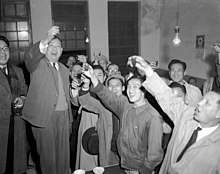
Capital punishment is still used in Taiwan, although efforts have been made by the government to reduce the number of executions.[175] Between 2005 and 2009, capital punishment was stopped.[176] Nevertheless, according to a survey in 2006, about 80% of Taiwanese still wanted to keep the death penalty.[175]
The Control Yuan is a watchdog agency that monitors (controls) the actions of the executive. It can be considered a standing commission for administrative inquiry and can be compared to the Court of Auditors of the European Union or the Government Accountability Office of the United States.[169]
The Examination Yuan is in charge of validating the qualification of civil servants. It is based on the old imperial examination system used in dynastic China. It can be compared to the European Personnel Selection Office of the European Union or the Office of Personnel Management of the United States.[169]
Major camps
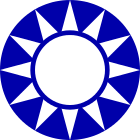
The tension between mainland China and Taiwan shades most of political life since it is the official policy of the PRC to meet any Taiwanese government move towards "Taiwan independence" with a threat of invasion.[177][114] The PRC's official policy is to reunify Taiwan and mainland China under the formula of "one country, two systems" and refuses to renounce the use of military force, especially should Taiwan seek a declaration of independence.[178]
The political scene is generally divided into two major camps in terms of views on how Taiwan should relate to China or the PRC, referred to as cross-Strait relations. It is the main political difference between two camps: the Pan-Blue Coalition, composed of the pro-unification Kuomintang, People First Party (PFP), and New Party, who believe that the ROC is the sole legitimate government of "China" (including Taiwan) and supports eventual Chinese reunification. The opposition Pan-Green Coalition is composed of the pro-independence DPP and Taiwan Solidarity Union (TSU). It regards Taiwan as an independent, sovereign state synonymous with the ROC, opposes the definition that Taiwan is part of "China", and seeks wide diplomatic recognition and an eventual declaration of formal Taiwan independence.[179] The Pan-Green camp tends to favour emphasizing the Republic of China as being a distinct country from the People's Republic of China. Thus, in September 2007, the then ruling Democratic Progressive Party approved a resolution asserting separate identity from China and called for the enactment of a new constitution for a "normal country". It called also for general use of "Taiwan" as the country's name, without abolishing its formal name, the "Republic of China".[180] Some members of the coalition, such as former President Chen Shui-bian, argue that it is unnecessary to proclaim independence because "Taiwan is already an independent, sovereign country" and the Republic of China is the same as Taiwan.[181] Despite being a member of KMT prior to and during his presidency, Lee Teng-hui also held a similar view and was a supporter of the Taiwanization movement.[182]
Pan-Blue members generally support the concept of the One-China policy, which states that there is only one China and that its only government is the ROC. They favour eventual re-unification of China.[183] The more mainstream Pan-Blue position is to lift investment restrictions and pursue negotiations with the PRC to immediately open direct transportation links. Regarding independence, the mainstream Pan-Blue position is to maintain the status quo, while refusing immediate reunification.[162] President Ma Ying-jeou stated that there will be no unification nor declaration of independence during his presidency.[184][185] As of 2009, Pan-Blue members usually seek to improve relationships with mainland China, with a current focus on improving economic ties.[186]
Current political issues
.jpg)
The dominant political issue in Taiwan is its relationship with the PRC. For almost 60 years, there were no direct transportation links, including direct flights, between Taiwan and mainland China. This was a problem for many Taiwanese businesses that had opened factories or branches in mainland China. The former DPP administration feared that such links would lead to tighter economic and political integration with mainland China, and in the 2006 Lunar New Year Speech, President Chen Shui-bian called for managed opening of links. Direct weekend charter flights between Taiwan and mainland China began in July 2008 under the KMT government, and the first direct daily charter flights took off in December 2008.[187]
Other major political issues include the passage of an arms procurement bill that the United States authorized in 2001.[188] In 2008, however, the United States were reluctant to send over more arms to Taiwan out of fear that it would hinder the recent improvement of ties between the PRC and the ROC.[189] Another major political issue is the establishment of a National Communications Commission to take over from the Government Information Office, whose advertising budget exercised great control over the media.[190]
The politicians and their parties have themselves become major political issues. Corruption among some DPP administration officials had been exposed. In early 2006, President Chen Shui-bian was linked to possible corruption. The political effect on President Chen Shui-bian was great, causing a division in the DPP leadership and supporters alike. It eventually led to the creation of a political camp led by ex-DPP leader Shih Ming-teh which believed the president should resign. The KMT assets continue to be another major issue, as it was once the richest political party in the world.[191] Nearing the end of 2006, KMT's chairman Ma Ying-jeou was also hit by corruption controversies, although he has since then been cleared of any wrongdoings by the courts.[192] After completing his second term as President, Chen Shui-bian was charged with corruption and money laundering.[193] Following his conviction, he is serving a 17-year sentence in Taipei Prison.[194]
Taiwan's leaders, including President Tsai and Premier William Lai, have repeatedly accused China of spreading fake news via social media to create divisions in Taiwanese society, influence voters and support candidates more sympathetic to Beijing ahead of the 2018 Taiwanese local elections.[195][196][197] China has been accused of conducting hybrid warfare against Taiwan.[198][199]
National identity
Roughly 84% of Taiwan's population are descendants of Han Chinese immigrants from Qing China between 1661 and 1895. Another significant fraction descends from Han Chinese who immigrated from mainland China in the late 1940s and early 1950s. The shared cultural origin combined with several hundred years of geographical separation, some hundred years of political separation and foreign influences, as well as hostility between the rival ROC and PRC have resulted in national identity being a contentious issue with political overtones. Since democratic reforms and the lifting of martial law, a distinct Taiwanese identity (as opposed to Taiwanese identity as a subset of a Chinese identity) is often at the heart of political debates. Its acceptance makes the island distinct from mainland China, and therefore may be seen as a step towards forming a consensus for de jure Taiwan independence.[200] The pan-green camp supports a distinct Taiwanese identity, while the pan-blue camp supports a Chinese identity only.[183] The KMT has downplayed this stance in the recent years and now supports a Taiwanese identity as part of a Chinese identity.[201][202]
According to a survey conducted in March 2009, 49% of the respondents consider themselves as Taiwanese only, and 44% of the respondents consider themselves as Taiwanese and Chinese. 3% consider themselves as only Chinese.[124] Another survey, conducted in Taiwan in July 2009, showed that 82.8% of respondents consider the ROC and the PRC as two separate countries with each developing on its own.[203] A survey conducted in December 2009 showed that 62% of the respondents consider themselves as Taiwanese only, and 22% of the respondents consider themselves as both Taiwanese and Chinese. 8% consider themselves as only Chinese. The survey also shows that among 18- to 29-year-old respondents, 75% consider themselves as Taiwanese only.[204]
In the latest survey conducted by National Chengchi University in 2014 and published in early 2015, 60.6% of respondents identified themselves exclusively as Taiwanese, 32.5% identified themselves as both Taiwanese and Chinese and 3.5% identified themselves as Chinese.
| Survey | Taiwanese | Chinese | Taiwanese and Chinese |
|---|---|---|---|
| Taiwanese Public Opinion Foundation (February 2020)[205] | 83.2% | 5.3% | 6.7% |
| National Chengchi University (January 2015)[206] | 60.6% | 3.5% | 32.5% |
| TVBS Poll Center (October 2012)[207] | 75% | 15% | (not an option for this question) |
| TVBS Poll Center (October 2012)[208] | 55% | 3% | 37% |
| Common Wealth Magazine (December 2009)[204] | 62% | 8% | 22% |
| Research, Development, and Evaluation Commission, Executive Yuan (April 2008) | 67.1% | 13.6% | 15.2% |
Administrative divisions
| Republic of China | .svg.png) Keelung
Hsinchu County
Hsinchu
Miaoli
Changhua
Nantou
Yunlin
Chiayi County
Chiayi
Pingtung
Yilan
Hualien
Taitung
Kinmen
Lienchiang (Matsu)
Fujian Province
Taiwan Strait
Bashi Channel
| ||||
| Free area[lower-roman 1] | Mainland area | ||||
| Special municipalities[G][lower-roman 2] | Provinces[lower-roman 3] | Not administered[lower-roman 4] | |||
| Counties[G] | Cities[G][lower-roman 5] | ||||
| Districts[O] | Mountain indigenous districts[G] | Townships and county-administered cities[G][lower-roman 6] | Districts[O] | ||
| Villages[O][lower-roman 7] | |||||
| Neighborhoods | |||||
- Notes
- [G] Has an administrative body with an elected leader and a legislative body with elected members
- [O] Has a governmental office for managing local affairs and carrying out commissioned tasks by superior agency
Taiwan is divided into 22 subnational divisions, each with a self-governing body led by an elected head and a legislative body with elected members. Local governments are responsible or partially responsible for social services, education, urban planning, public construction, water management, environmental protection, transport and public safety.
There are three types of subnational divisions: special municipalities, cities and counties. Special municipalities and cities are further divided into districts for local administration. Counties are further divided into townships and county-administered cities which have government offices with elected leaders and local councils, which share responsibilities with the county. Some divisions are indigenous divisions which have different degrees of autonomy to standard ones. In addition, districts, cities and townships are further divided into villages and neighbourhoods.
Military
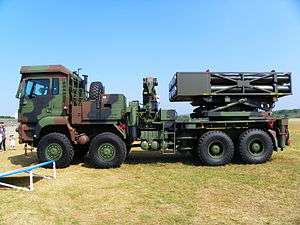
The Republic of China Army takes its roots in the National Revolutionary Army, which was established by Sun Yat-sen in 1925 in Guangdong with a goal of reunifying China under the Kuomintang. When the People's Liberation Army won the Chinese Civil War, much of the National Revolutionary Army retreated to Taiwan along with the government. It was later reformed into the Republic of China Army. Units which surrendered and remained in mainland China were either disbanded or incorporated into the People's Liberation Army.
Today, Taiwan maintains a large and technologically advanced military, mainly as a defence to the constant threat of invasion by the People's Liberation Army using the Anti-Secession Law of the People's Republic of China as a pretext. This law authorizes the use of military force when certain conditions are met, such as a danger to mainlanders.[126]
From 1949 to the 1970s, the primary mission of the Taiwanese military was to "retake mainland China" through Project National Glory. As this mission has transitioned away from attack because the relative strength of the PRC has massively increased, the ROC military has begun to shift emphasis from the traditionally dominant Army to the air force and navy.
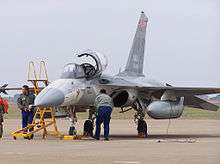
Control of the armed forces has also passed into the hands of the civilian government.[209][210] As the ROC military shares historical roots with the KMT, the older generation of high-ranking officers tends to have Pan-Blue sympathies. However, many have retired and there are many more non-mainlanders enlisting in the armed forces in the younger generations, so the political leanings of the military have moved closer to the public norm in Taiwan.[211]
The ROC began a force reduction plan, Jingshi An (translated to streamlining program), to scale down its military from a level of 450,000 in 1997 to 380,000 in 2001.[212] As of 2009, the armed forces of the ROC number approximately 300,000,[213] with nominal reserves totalling 3.6 million as of 2015.[214] Conscription remains universal for qualified males reaching age eighteen, but as a part of the reduction effort many are given the opportunity to fulfill their draft requirement through alternative service and are redirected to government agencies or arms related industries.[215] Current plans call for a transition to a predominantly professional army over the next decade.[216][217] Conscription periods are planned to decrease from 14 months to 12.[218] In the last months of the Bush administration, Taipei took the decision to reverse the trend of declining military spending, at a time when most Asian countries kept on reducing their military expenditures. It also decided to strengthen both defensive and offensive capabilities. Taipei still keeps a large military apparatus relative to the island's population: military expenditures for 2008 were NTD 334 billion (approximately US $10.5 billion), which accounted for 2.94% of GDP.
_and_Ma_Kong_(DDG-1805)_shipped_in_Zhongzheng_Naval_Base_20130504b.jpg)
The armed forces' primary concern at this time, according to the National Defense Report, is the possibility of an invasion by the PRC, consisting of a naval blockade, airborne assault, and/or missile bombardment.[209] Four upgraded Kidd-class destroyers were purchased from the United States, and commissioned into the Republic of China Navy in 2005–2006, significantly upgrading Taiwan's protection from aerial attack and submarine hunting abilities.[219] The Ministry of National Defense planned to purchase diesel-powered submarines and Patriot anti-missile batteries from the United States, but its budget has been stalled repeatedly by the opposition-Pan-Blue Coalition controlled legislature. The military package was stalled from 2001 to 2007 where it was finally passed through the legislature and the US responded on 3 October 2008, with a $6.5 billion arms package including PAC III Anti-Air systems, AH-64D Apache Attack helicopters and other arms and parts.[220] A significant amount of military hardware has been bought from the United States, and, as of 2009, continues to be legally guaranteed by the Taiwan Relations Act.[143] In the past, France and the Netherlands have also sold military weapons and hardware to the ROC, but they almost entirely stopped in the 1990s under pressure of the PRC.[221][222]
The first line of protection against invasion by the PRC is the ROC's own armed forces. Current ROC military doctrine is to hold out against an invasion or blockade until the US military responds.[223] There is, however, no guarantee in the Taiwan Relations Act or any other treaty that the United States will defend Taiwan, even in the event of invasion.[224] The joint declaration on security between the US and Japan signed in 1996 may imply that Japan would be involved in any response. However, Japan has refused to stipulate whether the "area surrounding Japan" mentioned in the pact includes Taiwan, and the precise purpose of the pact is unclear.[225] The Australia, New Zealand, United States Security Treaty (ANZUS Treaty) may mean that other US allies, such as Australia, could theoretically be involved.[226] In practice, the risk of losing economic ties with China may prevent Australia from taking action.[227]
Economy
.jpeg)
The quick industrialization and rapid growth of Taiwan during the latter half of the 20th century has been called the "Taiwan Miracle". Taiwan is one of the "Four Asian Tigers" alongside Hong Kong, South Korea and Singapore.
Japanese rule prior to and during World War II brought changes in the public and private sectors, most notably in the area of public works, which enabled rapid communications and facilitated transport throughout much of the island. The Japanese also improved public education and made it compulsory for all residents of Taiwan. By 1945, hyperinflation was in progress in mainland China and Taiwan as a result of the war with Japan. To isolate Taiwan from it, the Nationalist government created a new currency area for the island, and began a price stabilization programme. These efforts significantly slowed inflation.
When the KMT government fled to Taiwan it brought millions of taels (where 1 tael = 37.5 g or ~1.2 ozt) of gold and the foreign currency reserve of mainland China, which, according to the KMT, stabilized prices and reduced hyperinflation.[228] Perhaps more importantly, as part of its retreat to Taiwan, the KMT brought the intellectual and business elites from mainland China.[229] The KMT government instituted many laws and land reforms that it had never effectively enacted on mainland China. The government also implemented a policy of import-substitution, attempting to produce imported goods domestically.
In 1950, with the outbreak of the Korean War, the United States began an aid programme which resulted in fully stabilized prices by 1952.[230] Economic development was encouraged by American economic aid and programmes such as the Joint Commission on Rural Reconstruction, which turned the agricultural sector into the basis for later growth. Under the combined stimulus of the land reform and the agricultural development programmes, agricultural production increased at an average annual rate of 4 per cent from 1952 to 1959, which was greater than the population growth, 3.6%.[231]
In 1962, Taiwan had a (nominal) per-capita gross national product (GNP) of $170, placing its economy on a par with those of the Democratic Republic of the Congo. On a purchasing power parity (PPP) basis, its GDP per capita in the early 1960s was $1,353 (in 1990 prices). By 2011 per-capita GNP, adjusted for purchasing power parity (PPP), had risen to $37,000, contributing to a Human Development Index (HDI) equivalent to that of other developed countries. Taiwan's HDI in 2012 is 0.890, (23rd, very high), according to the UN's new "Inequality-adjusted HDI" calculation method.

In 1974, Chiang Ching-kuo implemented the Ten Major Construction Projects, the beginning foundations that helped Taiwan transform into its current export driven economy. Since the 1990s, a number of Taiwan-based technology firms have expanded their reach around the world. Well-known international technology companies headquartered in Taiwan include personal computer manufacturers Acer Inc. and Asus, mobile phone maker HTC, as well as electronics manufacturing giant Foxconn, which makes products for Apple, Amazon, and Microsoft. Computex Taipei is a major computer expo, held since 1981.
Today Taiwan has a dynamic, capitalist, export-driven economy with gradually decreasing state involvement in investment and foreign trade. In keeping with this trend, some large government-owned banks and industrial firms are being privatized.[232] Real growth in GDP has averaged about 8% during the past three decades. Exports have provided the primary impetus for industrialization. The trade surplus is substantial, and foreign reserves are the world's fifth largest.[233] The currency of Taiwan is the New Taiwan dollar.
Since the beginning of the 1990s, the economic ties between Taiwan and the People's Republic of China have been very prolific. As of 2008, more than US$150 billion[234] have been invested in the PRC by Taiwanese companies, and about 10% of the Taiwanese labour force works in the PRC, often to run their own businesses.[235] Although the economy of Taiwan benefits from this situation, some have expressed the view that the island has become increasingly dependent on the mainland Chinese economy. A 2008 white paper by the Department of Industrial Technology states that "Taiwan should seek to maintain stable relation with China while continuing to protect national security, and avoiding excessive 'Sinicization' of Taiwanese economy."[236] Others argue that close economic ties between Taiwan and mainland China would make any military intervention by the PLA against Taiwan very costly, and therefore less probable.[237]
Taiwan's total trade in 2010 reached an all-time high of US$526.04 billion, according to Taiwan's Ministry of Finance. Both exports and imports for the year reached record levels, totalling US$274.64 billion and US$251.4 billion, respectively.[238]

In 2001, agriculture constituted only 2% of GDP, down from 35% in 1952.[239] Traditional labour-intensive industries are steadily being moved offshore and with more capital and technology-intensive industries replacing them. High-technology industrial parks have sprung up in every region in Taiwan. The ROC has become a major foreign investor in the PRC, Thailand, Indonesia, the Philippines, Malaysia, and Vietnam. It is estimated that some 50,000 Taiwanese businesses and 1,000,000 businesspeople and their dependents are established in the PRC.[240]
Because of its conservative financial approach and its entrepreneurial strengths, Taiwan suffered little compared with many of its neighbours in the 1997 Asian financial crisis. Unlike its neighbours, South Korea and Japan, the Taiwanese economy is dominated by small and medium-sized businesses, rather than the large business groups. The global economic downturn, however, combined with poor policy co-ordination by the new administration and increasing bad debts in the banking system, pushed Taiwan into recession in 2001, the first whole year of negative growth since 1947. Due to the relocation of many manufacturing and labour-intensive industries to the PRC, unemployment also reached a level not seen since the 1970s oil crisis. This became a major issue in the 2004 presidential election. Growth averaged more than 4% in the 2002–2006 period and the unemployment rate fell below 4%.[241]
The ROC often joins international organizations (especially ones that also include the People's Republic of China) under a politically neutral name. The ROC has been a member of governmental trade organizations such as the World Trade Organization under the name Separate Customs Territory of Taiwan, Penghu, Kinmen and Matsu (Chinese Taipei) since 2002.[242]
Transport
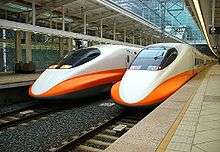
The Ministry of Transportation and Communications of the Republic of China is the cabinet-level governing body of the transport network in Taiwan.
Civilian transport in Taiwan is characterised by extensive use of scooters. In March 2019, 13.86 million were registered, twice that of cars.[243]
Both highways and railways are concentrated near the coasts where the majority of the population resides, with 1,619 km (1,006 mi) of motorway.
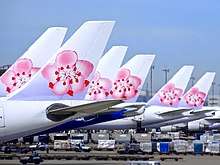
Railways in Taiwan are primarily used for passenger services, with Taiwan Railway Administration (TRA) operating a circular route and Taiwan High Speed Rail (THSR) running high speed services on the west coast. Urban transit systems include Taipei Metro, Kaohsiung Rapid Transit Taoyuan Metro and New Taipei Metro.
Major airports include Taiwan Taoyuan, Kaohsiung, Taipei Songshan and Taichung. There are currently seven airlines in Taiwan, the largest ones being China Airlines and EVA Air.
There are four international seaports: Keelung, Kaohsiung, Taichung, and Hualien.
Education
Taiwan's higher education system was established by Japan during the colonial period. However, after the Republic of China took over in 1945, the system was promptly replaced by the same system as in mainland China which mixed features of the Chinese and American educational systems.[244]
Taiwan is well known for adhering to the Confucian paradigm of valuing education as a means to improve one's socioeconomic position in society.[245][246] Heavy investment and a cultural valuing of education has catapulted the resource-poor nation consistently to the top of global education rankings. Taiwan is one of the top-performing countries in reading literacy, mathematics and sciences. In 2015, Taiwanese students achieved one of the world's best results in mathematics, science and literacy, as tested by the Programme for International Student Assessment (PISA), with the average student scoring 519, compared with the OECD average of 493, placing it seventh in the world.[247][248][249][250]
The Taiwanese education system has been praised for various reasons, including its comparatively high test results and its major role in promoting Taiwan's economic development while creating one of the world's most highly educated workforces.[251][252] Taiwan has also been praised for its high university entrance rate where the university acceptance rate has increased from around 20 per cent before the 1980s to 49 per cent in 1996 and over 95 per cent since 2008, among the highest in Asia.[253][254][255] The nation's high university entrance rate has created a highly skilled workforce making Taiwan one of the most highly educated countries in the world with 68.5% of Taiwanese high school students going on to attend university.[256] Taiwan has a high percentage of its citizens holding a tertiary education degree where 45 per cent of Taiwanese aged 25–64 hold a bachelor's degree or higher compared with the average of 33 per cent among member countries of the Organisation for Economic Cooperation and Development (OECD).[255][257]
On the other hand, the system has been criticised for placing excessive pressure on students while eschewing creativity and producing an excess supply of over-educated university graduates and a high graduate unemployment rate. With a large number of university graduates seeking a limited number of prestigious white collar jobs in an economic environment that is increasingly losing its competitive edge, this has led many graduates to be employed in lower end jobs with salaries far beneath than their expectations.[258][246] Taiwan's universities have also been under criticism for not being able to fully meet the requirements and demands of Taiwan's 21st century fast-moving job market citing a skills mismatch among a large number of self-assessed, overeducated university graduates that don't fit the demands of the modern Taiwanese labour market.[259] The Taiwanese government has also received criticism for undermining the economy as it has been unable to produce enough jobs to meet the demands of numerous underemployed university graduates.[253][260]
As the Taiwanese economy is largely science and technology based, the labour market demands people who have achieved some form of higher education, particularly related to science and engineering to gain a competitive edge when searching for employment. Although current Taiwanese law mandates only nine years of schooling, 95% of junior high graduates go on to attend a senior vocational high school, university, junior college, trade school, or other higher education institution.[256][261]
Many Taiwanese students attend cram schools, or buxiban, to improve skills and knowledge on problem solving against exams of subjects like mathematics, nature science, history and many others. Courses are available for most popular subjects and include lectures, reviews, private tutorial sessions, and recitations.[262][263]
As of 2018, the literacy rate in Taiwan is 98.87%.[264]
Demographics
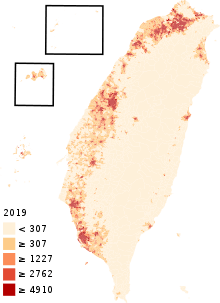
Taiwan has a population of about 23.4 million,[265] most of whom are on the island proper. The remainder live on Penghu (101,758), Kinmen (127,723), and Matsu (12,506).[266]
Largest cities and counties
The figures below are the March 2019 estimates for the twenty most populous administrative divisions; a different ranking exists when considering the total metropolitan area populations (in such rankings the Taipei-Keelung metro area is by far the largest agglomeration).
Ethnic groups
The ROC government reports that over 95% of the population is Han Chinese, of which the majority includes descendants of early Han Chinese immigrants who arrived in Taiwan in large numbers starting in the 18th century. Alternatively, the ethnic groups of Taiwan may be roughly divided among the Hoklo (70%), the Hakka (14%), the Waishengren (14%), and indigenous peoples (2%).[8]
The Hoklo people are the largest ethnic group (70% of the total population), whose Han ancestors migrated from the coastal southern Fujian region across the Taiwan Strait starting in the 17th century. The Hakka comprise about 15% of the total population, and descend from Han migrants to Guangdong, its surrounding areas and Taiwan. Additional people of Han origin include and descend from the 2 million Nationalists who fled to Taiwan following the communist victory on the mainland in 1949.[8]
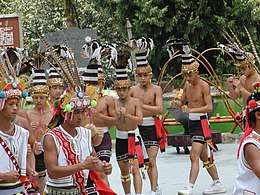
The indigenous Taiwanese aborigines number about 533,600 and are divided into 16 groups.[267] The Ami, Atayal, Bunun, Kanakanavu, Kavalan, Paiwan, Puyuma, Rukai, Saisiyat, Saaroa, Sakizaya, Sediq, Thao, Truku and Tsou live mostly in the eastern half of the island, while the Yami inhabit Orchid Island.[268][269]
Languages
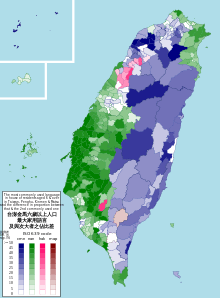
Mandarin is the primary language used in business and education, and is spoken by the vast majority of the population. Traditional Chinese is used as the writing system.[270]
Some 70 per cent of the population belong to the Hoklo ethnic group and speak Hokkien natively in addition to Mandarin. The Hakka group, comprising some 14–18 per cent of the population, speak Hakka. Although Mandarin is the language of instruction in schools and dominates television and radio, non-Mandarin Chinese varieties have undergone a revival in public life in Taiwan, particularly since restrictions on their use were lifted in the 1990s.[270]
Formosan languages are spoken primarily by the indigenous peoples of Taiwan. They do not belong to the Chinese or Sino-Tibetan language family, but to the Austronesian language family, and are written in Latin alphabet.[271] Their use among aboriginal minority groups has been in decline as usage of Mandarin has risen.[270] Of the 14 extant languages, five are considered moribund.[272]
Taiwan is officially multilingual. A national language in Taiwan is legally defined as "a natural language used by an original people group of Taiwan and the Taiwan Sign Language".[4] As of 2019, policies on national languages are in early stages of implementation, with Hakka and indigenous languages designated as such.
Religion
Estimated religious composition in 2020[273]
The Constitution of the Republic of China protects people's freedom of religion and the practices of belief.[274] Freedom of religion in Taiwan is strong.
In 2005, the census reported that the five largest religions were: Buddhism, Taoism, Yiguandao, Protestantism, and Roman Catholicism.[275] According to Pew Research, the religious composition of Taiwan in 2020[276] is estimated to become 43.8% Folk religions, 21.2% Buddhist, 13.7% Unaffiliated, 5.8% Christian and 15.5% other religions. Taiwanese aborigines comprise a notable subgroup among professing Christians: "...over 64% identify as Christian... Church buildings are the most obvious markers of Aboriginal villages, distinguishing them from Taiwanese or Hakka villages".[277] There has been a small Muslim community of Hui people in Taiwan since the 17th century.[278]
Confucianism is a philosophy that deals with secular moral ethics, and serves as the foundation of both Chinese and Taiwanese culture. The majority of Taiwanese people usually combine the secular moral teachings of Confucianism with whatever religions they are affiliated with.
As of 2009, there were 14,993 temples in Taiwan, approximately one place of worship per 1,500 residents. 9,202 of those temples were dedicated to Taoism and Buddhism. In 2008, Taiwan had 3,262 Churches, an increase of 145.[279]
A significant percentage of the population of Taiwan is nonreligious. Taiwan's strong human rights protections, lack of state-sanctioned discrimination, and generally high regard for freedom of religion or belief earned it a joint #1 ranking in the 2018 Freedom of Thought Report, alongside the Netherlands and Belgium.[280]
Taiwan is clearly an outlier in the top 3, all-clear countries. It is non-European, and demographically much more religious. But in its relatively open, democratic and tolerant society we have recorded no evidence of laws or social discrimination against members of the non-religious minority.[281]
LGBTQ
On 24 May 2017, the Constitutional Court ruled that then-current marriage laws had been violating the Constitution by denying Taiwanese same-sex couples the right to marry. The Court ruled that if the Legislative Yuan did not pass adequate amendments to Taiwanese marriage laws within two years, same-sex marriages would automatically become lawful in Taiwan.[282] On 17 May 2019, Taiwan's parliament approved a bill legalising same-sex marriage, making it the first in Asia to do so.[283][284]
Public health
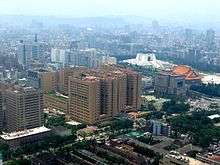
Health care in Taiwan is managed by the Bureau of National Health Insurance (BNHI).[285]
The current programme was implemented in 1995, and is considered to be a form of social insurance. The government health insurance programme maintains compulsory insurance for citizens who are employed, impoverished, unemployed, or victims of natural disasters with fees that correlate to the individual and/or family income; it also maintains protection for non-citizens working in Taiwan. A standard method of calculation applies to all persons and can optionally be paid by an employer or by individual contributions.[286]
BNHI insurance coverage requires co-payment at the time of service for most services unless it is a preventative health service, for low-income families, veterans, children under three years old, or in the case of catastrophic diseases. Low income households maintain 100% premium coverage by the BNHI and co-pays are reduced for disabled or certain elderly people.
According to a recently published survey, out of 3,360 patients surveyed at a randomly chosen hospital, 75.1% of the patients said they are "very satisfied" with the hospital service; 20.5% said they are "okay" with the service. Only 4.4% of the patients said they are either "not satisfied" or "very not satisfied" with the service or care provided.[287]
Taiwan has its own authority for disease control, and during the SARS outbreak in March 2003 there were 347 confirmed cases. During the outbreak the disease control bureaux and local governments set up monitored stations throughout public transportation, recreational sites and other public areas. With full containment in July 2003, there has not been a case of SARS since.[288]
As of 2017, the BNHI Facility Contract Distribution facilities total 28,339, including:[289]
| Number | Subject |
|---|---|
| 20,271 | outpatient-only facilities |
| 6,662 | dental clinics |
| 3,589 | Chinese medicine clinics |
| 809 | inpatient/outpatient facilities |
| 364 | local community hospitals |
| 5 | Chinese medicine hospitals |
| 26 | academic medical centres |
Basic coverage areas of the insurance include:
- In-patient care
- Ambulatory care
- Laboratory tests
- Prescription and over-the-counter drugs
- Dental services
- Mental Illness
- Traditional Chinese medicine
- Home care
- Preventative services (check-ups, prenatal care, pap smears)
In 2004, the infant mortality rate was 5.3 with 15 physicians and 63 hospital beds per 10,000 people. The life expectancy for males was 73.5 years and 79.7 years for females according to the World Health Report.
In July 2013, the Department of Health was restructured as the Ministry of Health and Welfare.[290]
| Period | Life expectancy in years |
Period | Life expectancy in years |
|---|---|---|---|
| 1950–1955 | 58.2 | 1985–1990 | 73.4 |
| 1955–1960 | 62.9 | 1990–1995 | 74.4 |
| 1960–1965 | 65.0 | 1995–2000 | 75.2 |
| 1965–1970 | 66.9 | 2000–2005 | 76.9 |
| 1970–1975 | 69.4 | 2005–2010 | 78.2 |
| 1975–1980 | 70.8 | 2010–2015 | 79.2 |
| 1980–1985 | 72.1 |
Source: UN World Population Prospects[291]
Culture
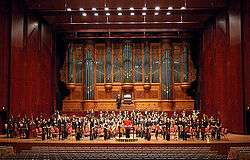
The cultures of Taiwan are a hybrid blend of various sources, incorporating elements of traditional Chinese culture, attributable to the historical and ancestral origin of the majority of its current residents, Japanese culture, traditional Confucianist beliefs, and increasingly Western values.
After their move to Taiwan, the Kuomintang imposed an official interpretation of traditional Chinese culture over Taiwan. The government launched a policy promoting Chinese calligraphy, traditional Chinese painting, folk art, and Chinese opera.
The status of Taiwanese culture is debated.[292] It is disputed whether Taiwanese culture is a regional form of Chinese culture or a distinct culture. Reflecting the continuing controversy surrounding the political status of Taiwan, politics continues to play a role in the conception and development of a Taiwanese cultural identity, especially in the prior dominant frame of a Taiwanese and Chinese dualism. In recent years, the concept of Taiwanese multiculturalism has been proposed as a relatively apolitical alternative view, which has allowed for the inclusion of mainlanders and other minority groups into the continuing re-definition of Taiwanese culture as collectively held systems of meaning and customary patterns of thought and behaviour shared by the people of Taiwan.[293] Identity politics, along with the over one hundred years of political separation from mainland China, has led to distinct traditions in many areas, including cuisine and music.

One of Taiwan's greatest attractions is the National Palace Museum, which houses more than 650,000 pieces of Chinese bronze, jade, calligraphy, painting, and porcelain and is considered one of the greatest collections of Chinese art and objects in the world.[294] The KMT moved this collection from the Forbidden City in Beijing in 1933 and part of the collection was eventually transported to Taiwan during the Chinese Civil War. The collection, estimated to be one-tenth of China's cultural treasures, is so extensive that only 1% is on display at any time. The PRC had said that the collection was stolen and has called for its return, but the ROC has long defended its control of the collection as a necessary act to protect the pieces from destruction, especially during the Cultural Revolution. Relations regarding this treasure have warmed recently; Beijing Palace Museum Curator Zheng Xinmiao said that artefacts in both Chinese and Taiwanese museums are "China's cultural heritage jointly owned by people across the Taiwan Strait".[295]
The classical music culture in Taiwan is highly developed and features artists such as violinist Cho-Liang Lin, pianist Ching-Yun Hu, and the Lincoln Center Chamber Music Society Artist Director Wu Han. Karaoke, drawn from contemporary Japanese culture, is extremely popular in Taiwan, where it is known as KTV. KTV businesses operate in a hotel-like style, renting out small rooms and ballrooms according to the number of guests in a group. Many KTV establishments partner with restaurants and buffets to form all-encompassing and elaborate evening affairs for families, friends, or businessmen. Tour buses that travel around Taiwan have several TV's, equipped not for watching movies, but primarily for singing Karaoke. The entertainment counterpart of a KTV is an MTV, being found much less frequently out of the city. There, movies out on DVD can be selected and played in a private theatre room. However, MTV, more so than KTV, has a growing reputation for being a place that young couples will go to be alone and intimate.
Taiwan has a high density of 24-hour convenience stores, which, in addition to the usual services, provide services on behalf of financial institutions or government agencies such as collection of parking fees, utility bills, traffic violation fines, and credit card payments.[296] They also provide a service for mailing packages.
Taiwanese culture has also influenced other cultures. Bubble tea and milk tea are available in Singapore, Malaysia, the Philippines, Australia, Europe, and North America. Taiwanese television shows are popular in Singapore, Malaysia, and other Asian countries. Taiwanese films have won various international awards at film festivals around the world. Ang Lee, a Taiwanese director, has directed critically acclaimed films such as: Crouching Tiger, Hidden Dragon; Eat Drink Man Woman; Sense and Sensibility; Brokeback Mountain; Life of Pi; and Lust, Caution. Other famous Taiwanese directors include Tsai Ming-liang, Edward Yang, and Hou Hsiao-hsien.
Sports
_cropped.jpg)
Baseball is Taiwan's national sport and is a popular spectator sport. There have been fifteen Taiwanese Major League Baseball players in the United States, notably including pitchers Chien-Ming Wang and Wei-Yin Chen. The Chinese Professional Baseball League in Taiwan was established in 1989,[297] and eventually absorbed the competing Taiwan Major League in 2003. As of 2015, the CPBL has four teams with average attendance over 5,000 per game.[298]
Besides baseball, basketball is Taiwan's other major sport.[299]
Taiwan participates in international sporting organizations and events under the name of "Chinese Taipei" due to its political status. In 2009, Taiwan hosted two international sporting events on the island. The World Games 2009 were held in Kaohsiung between 16 and 26 July 2009. Taipei hosted the 21st Summer Deaflympics in September of the same year. Furthermore, Taipei hosted the Summer Universiade in 2017.[300]
Taekwondo has become a mature and successful sport in Taiwan in recent years. In the 2004 Olympics, Chen Shih-hsin and Chu Mu-yen won the first two gold medals in women's flyweight event and men's flyweight event, respectively. Subsequent taekwondo competitors such as Yang Shu-chun have strengthened Taiwan's taekwondo culture.
Taiwan has a long history of strong international presence in table tennis. Chen Pao-pei was a gold medalist in the women's singles at the Asian Table Tennis Championships in 1953 and gold medalist with Chiang Tsai-yun in the 1957 women's doubles and women's team events. Lee Kuo-ting won the men's singles at the 1958 Asian Table Tennis Championships. More recently Chen Chien-an won the 2008 World Junior Table Tennis Championships in singles and pairing with Chuang Chih-yuan won the men's doubles in 2013 at the 52nd World Table Tennis Championships. Playing for Taiwan Chen Jing won a bronze medal at the 1996 Olympic Games and a silver medal at the 2000 Olympic Games. 17-year-old Lin Yun-Ju upset both reigning world champion Ma Long and world ranked No. 3 Fan Zhendong to win the 2019 men's singles in the T2 Diamond Series in Malaysia.[301][302][303][304]
In lawn tennis, Hsieh Su-wei is the country's most successful player, having been ranked inside the top 25 in singles in the WTA rankings.[305] She became joint No. 1 in doubles with her partner Peng Shuai in 2014.[306] The sisters Chan Yung-jan (Latisha Chan) and Chan Hao-ching are doubles specialists. They won their 13th WTA tournament together at the 2019 Eastbourne International,[307] the second-highest number of wins for a pair of sisters after the Williams sisters.[308] Latisha Chan became joint No. 1 with partner Martina Hingis in 2017.[309] The most successful men's player was Lu Yen-hsun, who reached No. 33 in the ATP rankings in 2010.[310]
Taiwan is also a major Asian country for Korfball. In 2008, Taiwan hosted the World Youth Korfball Championship and took the silver medal.[311] In 2009, Taiwan's korfball team won a bronze medal at the World Game.[312]
Yani Tseng is the most famous Taiwanese professional golfer currently playing on the US-based LPGA Tour. She is the youngest player ever, male or female, to win five major championships and was ranked number 1 in the Women's World Golf Rankings for 109 consecutive weeks from 2011 to 2013.[313][314][315]
Calendar
The standard Gregorian calendar is used for most purposes in Taiwan. The year is often denoted by the Minguo era system which starts in 1912, the year the ROC was founded. 2020 is year 109 Minguo (民國109年). This notation is most used by the government. The East Asian date format is used in Chinese.[316]
Prior to standardisation in 1929, the official calendar was a lunisolar system, which remains in use today for traditional festivals such as the Lunar New Year, the Lantern Festival, and the Dragon Boat Festival.[317]
See also
- Index of Taiwan-related articles
- Outline of Taiwan
- Taiwan, China
- Taiwan Province, People's Republic of China
Notes
- A national language in Taiwan is legally defined as "a natural language used by an original people group of Taiwan and the Taiwan Sign Language".[4]
- Not designated but meets legal definition
- 220 V is also used for high power appliances such as air conditioners
- Although this is the present meaning of guó, in Old Chinese (when its pronunciation was something like /*qʷˤək/)[41] it meant the walled city of the Chinese and the areas they could control from them.[42]
- Its use is attested from the 6th-century Classic of History, which states "Huangtian bestowed the lands and the peoples of the central state to the ancestors" (皇天既付中國民越厥疆土于先王).[43]
- Also known as the Taiwan area or Tai–Min area (Chinese: 臺閩地區; literally: 'Taiwan–Fujian area')
- In Chinese, special municipalities, cities, and county-administered cities have the word shi (Chinese: 市; literally: 'city') in their official names
- Nominal; provincial governments have been abolished
- Constitutionally having the same structure as the free area
- Cities are sometimes called provincial cities (Chinese: 省轄市) to distinguish them from the other two types of cities.
- In Chinese, there are two types of townships: xīang (Chinese: 鄉) and zhèng (Chinese: 鎮); there is little practical difference between the two
- In Chinese, villages of xīang townships are known as tsūn (Chinese: 村), those of other types are known as lǐ (Chinese: 里)
Words in native languages
-
- Chinese script: 中華民國
- Mandarin Pinyin: Zhōnghuá Mínguó
- Hokkien: Tiong-hûa Bîn-kok
- Sixian Hakka: Chûng-fà Mìn-koet
-
- Chinese script: 臺灣 or 台灣
- Mandarin Pinyin: Táiwān
- Hokkien: Tâi-uân
- Sixian Hakka: Tǒi-vǎn
- Amis: Taywan
- Paiwan: Taiwan
References
Citations
- http://multilingual.mofa.gov.tw/web/web_UTF-8/MOFA/glance2019-2020/English.pdf
- https://www.bbc.com/news/world-asia-51104246
- "Interior minister reaffirms Taipei is ROC's capital". Taipei Times. 5 December 2013. Retrieved 7 December 2013.
- 國家語言發展法. law.moj.gov.tw (in Chinese). Retrieved 22 May 2019.
- "Indigenous Languages Development Act". law.moj.gov.tw. Retrieved 22 May 2019.
- "Hakka Basic Act". law.moj.gov.tw. Retrieved 22 May 2019.
- "TAIWAN SNAPSHOT". Retrieved 15 March 2020.
- "Taiwan". The World Factbook. United States Central Intelligence Agency. Retrieved 6 May 2019.
- "Statistics from Statistical Bureau". National Statistics, Republic of China (Taiwan). Retrieved 31 August 2019.
- "General Statistical analysis report, Population and Housing Census" (PDF). National Statistics, ROC (Taiwan). Archived from the original (PDF) on 26 December 2016. Retrieved 26 November 2016.
- "World Economic Outlook Database, October 2019". IMF.org. International Monetary Fund. Retrieved 30 October 2019.
- "Percentage share of disposable income by quintile groups of income recipients and measures of income distribution". stat.gov.tw. Retrieved 26 June 2019.
- "Sub-national HDI - Subnational HDI - Global Data Lab". globaldatalab.org. Retrieved 17 April 2020.
- "ICANN Board Meeting Minutes". ICANN. 25 June 2010.
- http://multilingual.mofa.gov.tw/web/web_UTF-8/MOFA/glance2019-2020/English.pdf
- https://www.bbc.com/news/world-asia-51104246
- Fell, Dafydd (2018). Government and Politics in Taiwan. London: Routledge. p. 305. ISBN 978-1317285069.
Moreover, its status as a vibrant democratic state has earned it huge international sympathy and a generally positive image.
- Campbell, Matthew (13 January 2020). "Frayed in Taiwan". Bloomberg Businessweek (4642): 34–39. ISSN 0007-7135.
... the Taiwanese state ... By almost any functional standard, it's a sovereign country
- World Bank Country and Lending Groups Archived 11 January 2018 at the Wayback Machine, World Bank. Retrieved 10 July 2018.
- "IMF Advanced Economies List. World Economic Outlook, April 2016, p. 148" (PDF). Archived from the original (PDF) on 21 April 2016.
- "Freedom in the World 2019". freedomhouse.org. 3 January 2019. Retrieved 22 February 2019.
- Yao, Grace; Cheng, Yen-Pi; Cheng, Chiao-Pi (5 November 2008). "The Quality of Life in Taiwan". Social Indicators Research. 92 (2): 377–404. doi:10.1007/s11205-008-9353-1.
a second place ranking in the 2000 Economist's world healthcare ranking
- 2010中華民國人類發展指數 (HDI) (PDF) (in Chinese). Directorate General of Budget, Accounting and Statistics, Executive Yuan, R.O.C. 2010. Retrieved 2 July 2010.
- Dou, Eva. "Solomon Islands Ends Diplomatic Ties with Taiwan, Stands by China". The Wall Street Journal. Retrieved 16 September 2019.
- "Kiribati cuts ties with Taiwan in diplomatic switch to China days after Solomon Islands pivot". Australian Broadcasting Corporation. 20 September 2019. Retrieved 20 September 2019.
- Fell, Dafydd (2006). Party Politics in Taiwan. Routledge. p. 85. ISBN 978-1-134-24021-0.
- Achen, Christopher H.; Wang, T. Y. (2017). "The Taiwan Voter: An Introduction". In Achen, Christopher H.; Wang, T. Y. (eds.). The Taiwan Voter. University of Michigan Press. pp. 1–25. doi:10.3998/mpub.9375036. ISBN 978-0-472-07353-5. pp. 1–2.
- Bilik, Naran (2015), "Reconstructing China beyond Homogeneity", Patriotism in East Asia, Political Theories in East Asian Context, Abingdon: Routledge, p. 105
- "Chapter 3: History" (PDF). The Republic of China Yearbook 2011. Government Information Office, Republic of China (Taiwan). 2011. p. 46. Archived from the original (PDF) on 14 May 2012.
- "Ilha Formosa: the Emergence of Taiwan on the World Scene in the 17th Century". npm.gov.tw.
- Davidson (1903), p. 10: "A Dutch navigating officer named Linschotten [sic], employed by the Portuguese, so recorded the island in his charts, and eventually the name of Formosa, so euphonious and yet appropriate, replaced all others in European literature."
- see for example:
- Campbell, William (1915). Sketches from Formosa. London: Marshall Brothers. OL 7051071M.CS1 maint: ref=harv (link)
- Campbell (1903)
- Davidson (1903)
- Valentijn (1903), p. 52.
- Mair, V. H. (2003). "How to Forget Your Mother Tongue and Remember Your National Language".
The true derivation of the name "Taiwan" is actually from the ethnonym of a tribe in the southwest part of the island in the area around Ping'an. As early as 1636, a Dutch missionary referred to this group as Taiouwang. From the name of the tribe, the Portuguese called the area around Ping'an as Tayowan, Taiyowan, Tyovon, Teijoan, Toyouan, and so forth. Indeed, already in his ship's log of 1622, the Dutchman Cornelis Reijersen referred to the area as Teijoan and Taiyowan.
- 蔡玉仙; et al., eds. (2007). 府城文史 (in Chinese). Tainan City Government. ISBN 978-986-00-9434-3.
- Shih Shou-chien, ed. (2003). 福爾摩沙 : 十七世紀的臺灣、荷蘭與東亞 [Ilha Formosa: the Emergence of Taiwan on the World Scene in the 17th Century] (in Chinese). Taipei: National Palace Museum. ISBN 978-957-562-441-5.
- Kato, Mitsutaka (2007) [1940]. 昨日府城 明星台南: 發現日治下的老臺南 (in Chinese). Translated by 黃秉珩. 臺南市文化資產保護協會. ISBN 978-957-28079-9-6.
- Oosterhoff, J.L. (1985). "Zeelandia, a Dutch colonial city on Formosa (1624–1662)". In Ross, Robert; Telkamp, Gerard J. (eds.). Colonial Cities: Essays on Urbanism in a Colonial Context. Springer. pp. 51–62. ISBN 978-90-247-2635-6.
- Thompson (1964), p. 166.
- Thompson (1964), p. 163.
- Baxter-Sagart.
- Wilkinson, Endymion (2000), Chinese History: A Manual, Harvard-Yenching Institute Monograph No. 52, Cambridge: Harvard University Asia Center, p. 132, ISBN 978-0-674-00249-4
- 《尚書》, 梓材. (in Chinese)
- Garver, John W. (April 1997). The Sino-American Alliance: Nationalist China and American Cold War Strategy in Asia. M.E. Sharp. ISBN 978-0-7656-0025-7.
- "Office of President of the Republic of China (Taiwan)". Retrieved 15 July 2015.
- Reid, Katie (18 May 2009). "Taiwan hopes WHO assembly will help boost its profile". Reuters. Retrieved 11 June 2013.
- Chang, K.C. (1989). translated by W. Tsao, ed. by B. Gordon. "The Neolithic Taiwan Strait" (PDF). Kaogu. 6: 541–550, 569. Archived from the original (PDF) on 18 April 2012.
- Olsen, John W.; Miller-Antonio, Sari (1992). "The Palaeolithic in Southern China". Asian Perspectives. 31 (2): 129–160. hdl:10125/17011.
- Jiao (2007), pp. 89–90.
- Jiao (2007), pp. 91–94.
- Diamond, Jared M (2000). "Taiwan's gift to the world" (PDF). Nature. 403 (6771): 709–710. doi:10.1038/35001685. PMID 10693781. Archived from the original (PDF) on 16 September 2006.
- Fox, James J (2004). "Current Developments in Comparative Austronesian Studies" (PDF). Symposium Austronesia. Universitas Udayana, Bali.
- Shepherd, John R. (1993). Statecraft and Political Economy on the Taiwan Frontier, 1600–1800. Stanford University Press. pp. 7–8. ISBN 978-0-8047-2066-3. Reprinted Taipei: SMC Publishing, 1995.
- Wills, John E., Jr. (2006). "The Seventeenth-century Transformation: Taiwan under the Dutch and the Cheng Regime". In Rubinstein, Murray A. (ed.). Taiwan: A New History. M.E. Sharpe. pp. 84–106. ISBN 978-0-7656-1495-7.
- Andrade, Tonio (2007). How Taiwan Became Chinese. (Project Gutenberg Edition). Columbia University Press. chapter 6, note 5. ISBN 978-962-209-083-5.
- Campbell, William (1903). Formosa Under the Dutch: Described from Contemporary Records, with Explanatory Notes and a Bibliography of the Island. Kegan Paul, Trench, Trubner. pp. 6–7.CS1 maint: ref=harv (link)
- Skoggard, Ian A. (1996). The Indigenous Dynamic in Taiwan's Postwar Development: The Religious and Historical Roots of Entrepreneurship. M.E. Sharpe. ISBN 9781563248467. OL 979742M. p. 10
- 三年小反五年大亂. 台灣海外網 (in Chinese).
- Davidson (1903), pp. 247, 620.
- Shiba, Ryōtarō (1995). Taiwan kikō : kaidō o yuku yonjū 台湾紀行: 街道をゆく〈40〉 (in Japanese). Tōkyō: Asahi Shinbunsha. ISBN 978-4-02-256808-3.
- Morris, Andrew (2002). "The Taiwan Republic of 1895 and the failure of the Qing modernizing project". In Corcuff, Stéphane (ed.). Memories of the future: national identity issues and the search for a new Taiwan. M.E. Sharpe. pp. 3–24. ISBN 978-0-7656-0792-8.
- "History of Taiwan". Windows on Asia. Asian Studies Center, Michigan State University. Archived from the original on 1 September 2006. Retrieved 3 December 2014.
- Chou, Chuing Prudence; Ho, Ai-Hsin (2007). "Schooling in Taiwan". In Postiglione, Gerard A.; Tan, Jason (eds.). Going to school in East Asia. Greenwood Publishing Group. pp. 344–377. ISBN 978-0-313-33633-1. Archived from the original on 19 April 2010.
- Hsu, Mutsu (1991). Culture, Self and Adaptation: The Psychological Anthropology of Two Malayo-Polynesian Groups in Taiwan. Taipei, Taiwan: Institute of Ethnology, Academia Sinica. ISBN 978-957-9046-78-7.
- "History". The Republic of China Yearbook 2001. Government Information Office. 2001. Archived from the original on 27 October 2003.
- Tierney, Robert (2010). Tropics of Savagery: The Culture of Japanese Empire in Comparative Frame. University of California Press. pp. 8–9. ISBN 978-0-520-94766-5.
- 吕正惠:战后台湾左翼思想状况漫谈一——日本剥削下的台湾社会. 18 November 2014.
- Kominka Movement – 台灣大百科全書 Encyclopedia of Taiwan. Taiwanpedia.culture.tw (5 August 2013). Retrieved 25 August 2013.
- Grajdanzev, A. J. (1942). "Formosa (Taiwan) Under Japanese Rule". Pacific Affairs. 15 (3): 311–324. doi:10.2307/2752241. JSTOR 2752241.
- "History". Oversea Office Republic of China (Taiwan). 2007. Archived from the original on 28 March 2007. Retrieved 2 July 2007.
- "Protesters demand justice from Japan on 'comfort women' (update) | Society – FOCUS TAIWAN – CNA ENGLISH NEWS". focustaiwan.tw.
- "Shu LinKou Air Station: World War II". Ken Ashley, U.S. military photo archives. Retrieved 14 June 2011.
- "Taiwan history: Chronology of important events". China Daily. Archived from the original on 16 April 2016. Retrieved 20 April 2016.
- China, Fiver thousand years of History and Civilization. City University Of Hong Kong Press. 2007. p. 116. ISBN 978-962-937-140-1. Retrieved 9 September 2014.
- Roy, Denny (2003). Taiwan: A Political History. Ithaca, New York: Cornell University Press. pp. 55, 56. ISBN 978-0-8014-8805-4.
- "Far East (Formosa and the Pescadores)". Hansard. 540 (cc1870–4). 4 May 1955. Retrieved 1 September 2010.
The sovereignty was Japanese until 1952. The Japanese Treaty came into force, and at that time Formosa was being administered by the Chinese Nationalists, to whom it was entrusted in 1945, as a military occupation.
- Charney, Jonathan I.; Prescott, J. R. V. (2000). "Resolving Cross-Strait Relations Between China and Taiwan". American Journal of International Law. 94 (3): 453–477. doi:10.2307/2555319. JSTOR 2555319.
After occupying Taiwan in 1945 as a result of Japan's surrender, the Nationalists were defeated on the mainland in 1949, abandoning it to retreat to Taiwan.
- 对台湾"228事件"性质与影响的再认识. China Today (in Chinese). 64 (4): 64. 1 April 2017.
- "This Is the Shame". Time. New York. 10 June 1946.
- "China: Snow Red & Moon Angel". Time. New York. 7 April 1947.
- Shackleton, Allan J. (1998). Formosa Calling: An Eyewitness Account of Conditions in Taiwan during the February 28th, 1947 Incident (PDF). Upland, California: Taiwan Publishing Company. OCLC 40888167. Retrieved 18 December 2014.
- Kubek, Anthony (1963). How the Far East was lost: American policy and the creation of Communist China. ISBN 978-0-85622-000-5.
- Huang, Fu-san (2010). 臺灣簡史-麻雀變鳳凰的故事 [A Brief History of Taiwan: A Sparrow Transformed into a Phoenix] (in Chinese). Government Information Office, Republic of China. Archived from the original on 29 April 2011. Retrieved 13 September 2009.
1949年,國民政府退守臺灣後,以臺北為戰時首都
- "Taiwan Timeline – Retreat to Taiwan". BBC News. 2000. Retrieved 21 June 2009.
- Dunbabin, J.P.D. (2008). The Cold War. Pearson Education. p. 187. ISBN 978-0-582-42398-5.
In 1949 Chiang Kai-shek had transferred to Taiwan the government, gold reserve, and some of the army of his Republic of China.
- Ng, Franklin (1998). The Taiwanese Americans. Greenwood Publishing Group. p. 10. ISBN 978-0-313-29762-5.
- "The One-China Principle and the Taiwan Issue". PRC Taiwan Affairs Office and the Information Office of the State Council. 2005. Archived from the original on 10 February 2006.
Section 1: Since the KMT ruling clique retreated to Taiwan, its regime has continued to use the designations 'Republic of China' and 'government of the Republic of China,' despite having long since completely forfeited its right to exercise state sovereignty on behalf of China.
- 三、 台灣戒嚴令 [III. Decree to establish martial law in Taiwan] (in Chinese). National Archives Administration, National Development Council. 2 October 2009. Retrieved 23 May 2012.
- "28 February 1947 – Taiwan's Holocaust Remembered – 60th Commemoration". New Taiwan, Ilha Formosa. 2007. Retrieved 2 July 2009.
- "Taiwan president apologises for 'white terror' era". Reuters. Archived from the original on 1 April 2019. Retrieved 2 July 2009.
- Gluck, Caroline (16 July 2008). "Taiwan sorry for white terror era". BBC News. London.
- US Department of Defense (1950). "Classified Teletype Conference, dated 27 June 1950, between the Pentagon and General Douglas MacArthur regarding authorization to use naval and air forces in support of South Korea. Papers of Harry S. Truman: Naval Aide Files". Truman Presidential Library and Museum: 1 and 4.
Page 1: In addition 7th Fleet will take station so as to prevent invasion of Formosa and to insure that Formosa not be used as base of operations against Chinese mainland." Page 4: "Seventh Fleet is hereby assigned to operational control CINCFE for employment in following task hereby assigned CINCFE: By naval and air action prevent any attack on Formosa, or any air or sea offensive from Formosa against mainland of China.
Cite journal requires|journal=(help) - Alagappa, Muthiah (2001). Taiwan's presidential politics. M.E. Sharpe. p. 265. ISBN 978-0-7656-0834-5.
- "Taiwan Timeline – Cold war fortress". BBC News. 2002. Retrieved 2 July 2009.
- Makinen & Woodward (1989): "Yet, the Chinese Nationalist government attempted to isolate Taiwan from the mainland inflation by creating it as an independent currency area. And during the later stages of the civil war it was able to end the hyperinflation on Taiwan, something it was unable to do on the mainland despite two attempts."
- "China: Chiang Kai-shek: Death of the Casualty". Time. 14 April 1975. p. 3. Retrieved 16 December 2009.
- Sun, Yat-sen; Julie Lee Wei; Ramon Hawley Myers; Donald G. Gillin (1994). Julie Lee Wei; Ramon Hawley Myers; Donald G. Gillin (eds.). Prescriptions for saving China: selected writings of Sun Yat-sen. Hoover Press. p. 36. ISBN 978-0-8179-9281-1.
The party first applied Sun's concept of political tutelage by governing through martial law, not tolerating opposition parties, controlling the public media, and using the 1947 constitution drawn up on the China mainland to govern. Thus, much of the world in those years gave the government low scores for democracy and human rights but admitted it had accomplished an economic miracle.
- Chao, Linda; Ramon Hawley Myers (1997). Democracy's new leaders in the Republic of China on Taiwan. Hoover Press. p. 3. ISBN 978-0-8179-3802-4.
Although this party [the KMT] had initiated a democratic breakthrough and guided the democratic transition, it had also upheld martial law for thirty-six years and severely repressed political dissent and any efforts to establish an opposition party. [...] How was it possible that this party, so hated by opposition politicians and long regarded by Western critics as a dictatorial, Leninist-type party, still remained in power?
- Fung (2000), p. 67: "Nanjing was not only undemocratic and repressive but also inefficient and corrupt. [...] Furthermore, like other authoritarian regimes, the GMD sought to control people's mind."
- Fung (2000), p. 85: "The response to national emergency, critics argued, was not merely military, it was, even more important, political, requiring the termination of one-party dictatorship and the development of democratic institutions."
- Copper, John Franklin (2005). Consolidating Taiwan's democracy. University Press of America. p. 8. ISBN 978-0-7618-2977-5.
Also, the "Temporary Provisions" (of the Constitution) did not permit forming new political parties, and those that existed at this time did not seriously compete with the Nationalist Party. Thus, at the national level the KMT did not permit competitive democratic elections.
- "Out with the old". BBC News. 2002. Retrieved 30 October 2009.
- Influence of Constitutional Reform on Parliamentary System in Taiwan: From the Perspective of the Abolishment of the National Assembly (thesis). Graduate Institute of National Development, National Taiwan University, the Republic of China. 29 November 2014.
- Judit Árokay; Jadranka Gvozdanović; Darja Miyajima (2014). Divided Languages?: Diglossia, Translation and the Rise of Modernity in Japan, China, and the Slavic World. Springer Science. p. 73. ISBN 978-3-319-03521-5.
- "Taiwan Timeline – Path to democracy". BBC News. 2002. Retrieved 3 July 2009.
- "Annotated Republic of China Laws/Additional Articles of the Constitution of the Republic of China/1997". Wikibooks. 22 April 2015. Retrieved 15 September 2017.
- Pomfret, James; Miller, Matthew; Blanchard, Ben (17 January 2016). "After vote, China tells Taiwan to abandon independence "hallucination"". Reuters. Archived from the original on 11 February 2019.
- BBC News: Taiwan scraps unification council, 27 February 2006
- "Taiwan party asserts separate identity from China". USA Today.
- Lam, Willy (28 March 2008). "Ma Ying-jeou and the Future of Cross-Strait Relations". China Brief. 8 (7). Archived from the original (– Scholar search) on 13 April 2008. Retrieved 4 April 2008.CS1 maint: ref=harv (link)
- "The Nationalists are back in Taiwan". The Economist. London. 23 March 2008.
- "Straitened times: Taiwan looks to China". Financial Times. 25 March 2008.
- "Taiwan-China Economic Ties Boom, Military Tensions Remain | English". Voice of America. 20 August 2009. Retrieved 1 August 2010.
- "Taiwan President Calls For International Support To Defend Democracy". 4 January 2019. Retrieved 5 January 2019.
- "China Must Democratize for Taiwan Progress, President Tsai Says". 5 January 2019. Retrieved 6 January 2019.
- Exec. Yuan (2014), p. 44.
- Exec. Yuan (2014), p. 45.
- "Geology of Taiwan". University of Arizona. Retrieved 1 August 2010.
- Clift, Schouten and Draut (2003) in Intra-Oceanic Subduction Systems: Tectonic and Magmatic Processes, ISBN 1-86239-147-5 p84–86
- "USGS seismic hazard map of Eastern Asia". Seismo.ethz.ch. Archived from the original on 3 March 2000. Retrieved 30 May 2011.
- "The One-China Principle and the Taiwan Issue". PRC Taiwan Affairs Office and the Information Office of the State Council. 2005. Archived from the original on 13 February 2006. Retrieved 3 December 2014. Section 1: "Since the KMT ruling clique retreated to Taiwan, although its regime has continued to use the designations "Republic of China" and "government of the Republic of China," it has long since completely forfeited its right to exercise state sovereignty on behalf of mainland China and, in reality, has always remained only a separate state on the island of Taiwan."
- BBC News, "Taiwan Flashpoint", "But Taiwan's leaders say it is clearly much more than a province, arguing that it is a sovereign state. It has its own constitution, democratically elected leaders, and 400,000 troops in its armed forces."
- Chang, Bi-yu (2015). Place, Identity, and National Imagination in Post-war Taiwan. Oxon, UK, and New York City: Routledge. pp. 35–40, 46–60. ISBN 978-1-317-65812-2.
- "ECFA issues and the nationality identification" (PDF). TVBS. Archived from the original (PDF) on 21 May 2009.
- "Liancheng / Lianfeng Airbase – Chinese Military Forces". Federation of American Scientists. Retrieved 7 June 2009.
In March 2000 it was reported that the PLA Air Force was deploying new air-defense missiles [possibly batteries of Russian-made S-300 missiles] opposite Taiwan at the coastal cities of Xiamen and Shantou, and at Longtian, near Fuzhou.
- "2004 National Defense Report" (PDF). ROC Ministry of National Defense. 2004. pp. 89–90. Archived from the original (PDF) on 11 March 2006. Retrieved 5 March 2006.
The PRC refusal to renounce using military power against Taiwan, its current emphasis on 'enhancing preparation for military struggle', its obvious intention of preparing a war against Taiwan reflected in operational deployment, readiness efforts, and annual military exercises in the Southeast China coastal region, and its progress in aerospace operations, information warfare, paralyzing warfare, and non-conventional warfare, all of these factors work together so that the ROC Armed Forces face an increasingly complicated and difficult situation in terms of self-defense and counterattack. These multiple daunting challenges are testing our defense security.
- Forsythe, Michael (29 September 2014). "Protests in Hong Kong Have Roots in China's 'Two Systems'". The New York Times. Retrieved 14 April 2015.
- Chung, Lawrence (27 September 2014). "'One country, two systems' right formula for Taiwan, Xi Jinping reiterates". South China Morning Post. Retrieved 14 April 2015.
- "1992 Consensus basis for regular contact between cross-Strait affairs authorities: spokesman". CCTV News.
- Hong, Caroline (30 April 2005). "Lien, Hu share 'vision' for peace". Taipei Times. Retrieved 3 June 2016.
- Wang, Chris (12 February 2014). "MAC Minister Wang in historic meeting". Taipei Times. Retrieved 3 June 2016.
- "First minister-level Chinese official heads to Taipei for talks". Japan Times. 25 June 2014. ISSN 0447-5763. Retrieved 4 June 2016.
- Huang, Cary (5 November 2015). "Xi's a mister, so is Ma: China and Taiwan have an unusual solution for an old problem". South China Morning Post. Retrieved 12 November 2015.
- Chiao, Yuan-Ming (7 November 2015). "Cross-strait leaders meet after 66 years of separation". China Post. Archived from the original on 10 November 2015. Retrieved 3 June 2016.
- Lee, Shu-hua; Chang, S.C. "President Ma to meet China's Xi in Singapore Saturday (update)". Central News Agency. Retrieved 4 November 2015.
- "China says war with US would be a disaster as tensions mount". The Guardian. 2 June 2019. Retrieved 2 June 2019.
- Wong, Edward (12 March 2008). "Taiwan's Independence Movement Likely to Wane". The New York Times. Retrieved 12 February 2016.
- "Tsai, Lai voice support for Hong Kong extradition bill protesters". Focus Taiwan. The Central News Agency. 10 June 2019.
- "Countries – China". US Department of State, Office of the Historian. Retrieved 28 May 2009.
- Eyal Propper. "How China Views its National Security," The Israel Journal of Foreign Affairs, May 2008.
- Henckaerts, Jean-Marie (1996). The international status of Taiwan in the new world order. Martinus Nijhoff Publishers. pp. 96–97. ISBN 978-90-411-0929-3.
- Vang, Pobzeb (2008). Five Principles of Chinese Foreign Policies. AuthorHouse. p. 46. ISBN 978-1-4343-6971-0.
- Yates, Stephen J. (16 April 1999). "The Taiwan Relations Act After 20 Years: Keys to Past and Future Success". The Heritage Foundation. Archived from the original on 22 July 2009. Retrieved 19 July 2009.
- "China: US spat over Taiwan could hit co-operation". Agence France-Presse. 2 February 2010. Archived from the original on 6 February 2010. Retrieved 17 July 2014.
- Kelly, James A. (21 April 2004). "Overview of US Policy Towards Taiwan" (Press release). United States Department of State. Retrieved 17 July 2014.
- "US to sell arms to Taiwan despite Chinese opposition". BBC News. 16 December 2015.
- "Obama to push ahead on Taiwan frigate sales despite Chinese anger". CNBC. Reuters. 14 December 2015.
- "China warns against first major US-Taiwan arms sale in four years". The Guardian. Reuters. 16 December 2015.
- "Taiwan and the United Nations". New Taiwan. Retrieved 28 May 2009.
- "Taiwan". UNPO. Retrieved 7 May 2009.
- "About TFD". TFD.
- Tkacik, John (13 May 2009). "John Tkacik on Taiwan: Taiwan's 'undetermined' status". Taipei Times. Retrieved 28 May 2009.
- Su, Joy (19 May 2004). "WHO application: a question of health or politics?". Taipei Times.
- "Minister Chiu leads our WHA delegation to actively hold bilateral talks with delegations from other nations. This event has been the most successful medical-related diplomatic record over the past years". Republic of China: Ministry of Health and Welfare. 18 June 2014. Retrieved 27 January 2015.
- "ROC urges world public to support WHO bid". Taiwan Info. 3 May 2002. Archived from the original on 10 February 2015. Retrieved 27 January 2015.
- "Taiwan delegation to participate in WHA". Taiwan Today. 14 May 2010. Archived from the original on 19 January 2012. Retrieved 2 January 2015.
- "WHO Bows to China Pressure, Contravenes Human Rights in Refusing Taiwan Media". international.thenewslens.com. 18 May 2018. Retrieved 31 March 2020.
- Davidson, Helen (30 March 2020). "Senior WHO adviser appears to dodge question on Taiwan's Covid-19 response". The Guardian.
- Blanchard, Ben (24 January 2020). "Parties unite over Taiwan's exclusion from WHO anti-virus planning". Reuters. Retrieved 31 March 2020.
- "Taiwan insists on 'Chinese Taipei'". China Post. 25 July 2008. Retrieved 28 May 2009.
- "Taiwan flags in Salt Lake ruffle a few feelings". The Deseret News. 10 February 2002.
- "Looking behind Ma's 'three noes'". Taipei Times. 21 January 2008. Retrieved 28 May 2009.
- Enav, Peter (16 May 2008). "Unification with China unlikely 'in our lifetimes': president-elect". China Post. Retrieved 13 June 2009.
'It is very difficult for us to see any unification talks even in our lifetimes,' Ma said. 'Taiwanese people would like to have economic interactions with the mainland, but obviously they don't believe their political system is suitable for Taiwan.'
- Eckholm, Erik (22 March 2000). "Why a Victory in Taiwan Wasn't Enough for Some". The New York Times. Retrieved 28 May 2009.
- "Taiwan Flashpoint: Independence debate". BBC News. 2009.
Since neither outcome looks likely in the short or even medium term, it is perhaps not surprising that opinion polls suggest most Taiwanese people want things to stay as they are, with the island's ambiguous status unresolved.
- "Impulsa Taiwan la reconciliación". El Sol de México (in Spanish). 2 September 2008. Retrieved 9 June 2009.
Esencialmente, no definiríamos la relación a través del estrecho de Taiwan como una relación de dos países o dos Chinas, porque nuestra Constitución no lo permite. Nosotros definiríamos está relación como una relación muy especial, ya que la Constitución nuestra, igual que la Constitución de China continental, no permite la existencia de otro país dentro del territorio.
- "Taiwanese premier's independence stance incurs Beijing's wrath". TODAYonline. 28 September 2017. Retrieved 6 October 2017.
- "The Official Position of the Republic of China on China's Passing of the Anti-secession (Anti-Separation) Law" (Press release). Mainland Affairs Council, ROC Executive Yuan. 29 March 2005.
Section II-2: "'The Republic of China is an independent and sovereign state. Taiwan's sovereignty belongs to the 23 million people of Taiwan. Only the 23 million citizens of Taiwan may decide on the future of Taiwan.' This statement represents the greatest consensus within Taiwan's society today concerning the issues of national sovereignty and the future of Taiwan. It is also a common position shared by both the ruling and opposition parties in Taiwan. A recent opinion poll shows that more than 90% of the people of Taiwan agree with this position.
- "Chapter 4: Government". The Republic of China Yearbook. Government Information Office, Republic of China (Taiwan). 2011. pp. 55–65. Archived from the original (PDF) on 12 May 2008.
- Ginsburg, Tom (2003). Judicial review in new democracies. Cambridge University Press. p. 111. ISBN 978-0-521-52039-3.
- "Taiwan assembly passes changes". BBC News. 7 June 2005.
- Huang, Jei-hsuan (14 September 2006). "Letter: KMT holds the key". Taipei Times. p. 8. Retrieved 28 May 2009.
- Jayasuriya, Kanishka (1999). Law, capitalism and power in Asia. Routledge. p. 217. ISBN 978-0-415-19743-4.
- . Article 5 – via Wikisource.
- Chang, Rich (2 January 2006). "Nation keeps death penalty, but reduces executions". Taipei Times. Retrieved 2 November 2009.
- Sui, Cindy (27 October 2011). "Taiwan pays compensation for wrongful execution". BBC News. Retrieved 28 May 2019.
- "Country profile: Taiwan". BBC News. 11 September 2009. Retrieved 17 January 2010.
- "China's Threats, Editorial". The Washington Post. 23 February 2000. Retrieved 31 October 2011.
- BBC News, "Taiwan Flashpoint", "Officially, the DPP still favours eventual independence for Taiwan, while the KMT favours eventual re-unification."
- "Taiwan party asserts separate identity from China". USA Today. 30 September 2007. Retrieved 29 May 2009.
- Crisis Group (6 June 2003). "Taiwan Strait I: What's Left of 'One China'?". International Crisis Group. Archived from the original on 9 July 2008. Retrieved 29 May 2009.
- Shirk, Susan L. (2007). China: Fragile Superpower. Oxford University Press. ISBN 978-0-19-530609-5.
- Pares, Susan (24 February 2005). A political and economic dictionary of East Asia. Routledge. p. 267. ISBN 978-1-85743-258-9.
The Pan-Blue coalition on the whole favours a Chinese nationalist identity and policies supporting reunification and increased economic links with the People's Republic of China.
- Ko, Shu-Ling (8 October 2008). "Ma refers to China as ROC territory in magazine interview". Taipei Times.
- "Taiwan and China in 'special relations': Ma". China Post. 4 September 2008.
- "World | Asia-Pacific | Taiwan opposition leader in China". BBC News. 26 April 2005. Retrieved 28 May 2009.
- Yu, Sophie; Jane Macartney (16 December 2008). "Direct flights between China and Taiwan mark new era of improved relations". The Times. London. Retrieved 4 June 2009.
- Michael S. Chase (4 September 2008). "Caliber – Asian Survey – 48(4):703 – Abstract". Asian Survey. 48 (4): 703–724. doi:10.1525/as.2008.48.4.703.
- David Isenberg. "US Keeps Taiwan at Arm's Length". Cato.org. Retrieved 29 May 2009.
- "NCC relinquishes power over China-related media". Taipei Times. 9 August 2007. Retrieved 29 May 2009.
- Bristow, Michael (26 October 2001). "Wealth probe for 'world's richest' party". BBC News. Retrieved 12 November 2007.CS1 maint: ref=harv (link)
- "Court clears Ma of graft charges". China Post. 25 April 2008. Retrieved 29 May 2009.
- "Chen Shui-bian lied about Lien Chan-endorsed check". China Post. 3 October 2008. Retrieved 29 May 2009.
- Wang, Chris (26 July 2012). "Chen Shui-bian backers urge immediate release". Taipei Times. p. 3. Retrieved 13 August 2012.
- "'Fake news' rattles Taiwan ahead of elections". Al Jazeera. 23 November 2018.
- "Analysis: 'Fake news' fears grip Taiwan ahead of local polls". BBC Monitoring. 21 November 2018.
- "Fake news: How China is interfering in Taiwanese democracy and what to do about it". Taiwan News. 23 November 2018.
- "China's Hybrid Warfare and Taiwan". The Diplomat. 13 January 2018.
- "China's hybrid warfare against Taiwan". The Washington Post. 14 December 2018.
- Shambaugh, David L. (2006). Power shift. University of California Press. pp. 179–183. ISBN 978-0-520-24570-9.
- Okazaki, Hisahiko (30 December 2008). "No sign of a 'peace agreement'". Japan Times. Retrieved 15 July 2009.
For one thing, I believe there is recognition that the awareness of Taiwanese identity is now irreversible. The KMT government did things like rename the "Taiwan Post" to "Chunghwa Post" as soon as it came in. But it did not take much time to perceive that it would cause a backlash among the Taiwan populace. The cross-strait exchanges have also brought about opposition demonstrations from time to time. This appears to be one of the reasons for the abrupt decline in the approval rating of the Ma administration.
- "10 Questions: Ma Ying-jeou". Time. 10 July 2006. Retrieved 15 July 2009.
I am Taiwanese as well as Chinese.
- "Survey on President Ma's Approval Rating and Cross-Strait Relations After First Year of Direct Flights" (PDF). Global Views Survey Research Center. 24 July 2009. Archived from the original (PDF) on 29 April 2011. Retrieved 3 December 2014.
- 天下雜誌民調顯示:6成1民眾擔心經濟傾中 7成5年輕人自認台灣人 (in Chinese). Archived from the original on 23 March 2010.
- Lu, Yi-hsuan; Xie, Dennis (25 February 2020). "New high of 83.2% see themselves as Taiwanese: poll". Taipei Times. p. 1.
- Tseng, Wei-chen; Chen, Wei-han (26 January 2015). "'Taiwanese' identity hits record level". Taipei Times. p. 1.
- Quote: "Table 12: In Taiwan, some people identify themselves as Chinese, some identify themselves as Taiwan (sic). Do you identify yourself as Taiwanese or Chinese? (Do not prompt both Taiwanese and Chinese)"
- Quote: "Table 13: In Taiwan, some people identify themselves as Chinese, some identify themselves as Taiwan (sic). Do you identify yourself as Taiwanese, Chinese or both Taiwanese and Chinese?"
- Fravel, M. Taylor (2002). "Towards Civilian Supremacy: Civil-Military Relations in Taiwans's Democratization". Armed Forces & Society. 29 (1): 57–84. doi:10.1177/0095327X0202900104.
- "Committed to Taiwan". The Wall Street Journal. 26 April 2001. Retrieved 28 May 2009.
- Swaine & Mulvenon 2001, p. 65: "[...]the ROC military functioned until very recently as an instrument of KMT rule [...] the bulk of the officer corps is still composed of mainlanders, many of whom allegedly continue to support the values and outlook of more conservative KMT and New Party members. This is viewed as especially the case among the senior officers of the ROC Army. Hence, many DPP leaders insist that the first step to building a more secure Taiwan is to bring the military more fully under civilian control, to remove the dominant influence of conservative KMT elements, and to reduce what is regarded as an excessive emphasis on the maintenance of inappropriate ground force capabilities, as opposed to more appropriate air and naval capabilities."
- "Taiwan Yearbook 2004". Government Information Office, Republic of China. Archived from the original on 6 January 2012. Retrieved 28 May 2009.
- Bishop, Mac William (1 January 2004). "Women Take Command". Government Information Office, Republic of China. Archived from the original on 28 April 2011. Retrieved 5 June 2009.
- "Taiwan Yearbook 2005". Government Information Office, Republic of China. Archived from the original on 27 January 2010. Retrieved 28 May 2009.
- "ASIA-PACIFIC | Military alternative in Taiwan". BBC News. 1 May 2000. Retrieved 28 May 2009.
- "The myth: a professional military in five years". Taipei Times. 21 March 2009. Retrieved 28 May 2009.
- "Taiwan to end conscription". The Straits Times. 9 March 2009. Archived from the original on 13 March 2009. Retrieved 28 May 2009.
- "Taiwan to shorten conscription term to one year". Central News Agency website, Taipei. 3 December 2008. Retrieved 28 May 2009.
- "Kidd-class warships set sail for Taiwan". Taipei Times. 31 October 2005.
- Rickards, Jane (5 October 2008). "Taiwanese leader hails weapons deal with US". The Washington Post.
- Cabestan, Jean-Pierre (2001). "France's Taiwan Policy: A Case of Shopkeeper Diplomacy" (PDF). CERI. Retrieved 5 June 2009.
By excluding the French companies from the bidding lists of many contract, Peking wanted above all to stop a growing trend (...) to disregard its objections and interests in the Taiwan issue. (...) In spite of the ban of arms sales to Taiwan approved by the French government in January 1994, discreet and small-sized deals have continued to be concluded since then.
- "Taiwan trying to shore up weapons support". USA Today. 24 September 2004. Retrieved 28 May 2009.
- Swaine, Michael D.; Mulvenon, James C. (2001) [2001]. Taiwan's Foreign and Defense Policies: Features and Determinants (PDF). RAND Corporation. ISBN 978-0-8330-3094-8. Retrieved 23 May 2015.CS1 maint: ref=harv (link)
- "China Threat to Attack Taiwan Alarms Asia". Associated Press. 14 March 2005. Archived from the original on 11 April 2005.
- Kapstein, Ethan B.; Michael Mastanduno (1999). Unipolar politics. Columbia University Press. p. 194. ISBN 978-0-231-11309-0.
The Japanese leadership openly split on whether a crisis in Taiwan was included in the geographic expression "area surrounding Japan." In the event, Japan refused to stipulate the contingencies under which it would provide rear area support for U.S. forces or even the geographic scope of the "area surrounding Japan". (...) The two sides have not articulated clearly what the alliance stands for, nor who it is defined to protect against.
- Tow, William (2005). "ANZUS: Regional versus Global Security in Asia?". International Relations of the Asia-Pacific. 5 (2): 197–216. doi:10.1093/irap/lci113.CS1 maint: ref=harv (link)
- "China and Taiwan: flashpoint for a war". The Sydney Morning Herald. 14 July 2004. Retrieved 13 June 2009.
- "Gold Shipped to Taiwan in 1949 Helped Stabilize ROC on Taiwan". Kuomintang News Network. 6 April 2011. Archived from the original on 27 September 2011. Retrieved 14 June 2011. Translated from 王銘義 (5 April 2011). 1949年運台黃金 中華民國保命本. China Times. Retrieved 21 February 2015.
- Roy, Denny (2003). Taiwan: A Political History. Ithaca, NY: Cornell University Press. pp. 76, 77. ISBN 978-0-8014-8805-4.
- Makinen & Woodward 1989: "It was the fiscal regime change on Taiwan, as in the European episodes, that finally brought price stability. It was the aid policy that brought the budget to near balance, and when the aid programme reached its full proportions in 1952, prices stabilized."
- Ralph Clough, "Taiwan under Nationalist Rule, 1949–1982," in Roderick MacFarquar et al., ed., Cambridge History of China, Vol 15, The People's Republic Pt 2 (Cambridge: Cambridge University Press, 1991), p. 837
- Her, Kelly (12 January 2005). "Privatization Set in Motion". Taiwan Review. Archived from the original on 30 April 2011. Retrieved 5 June 2009.
- "Reserves of foreign exchange and gold". World Fact Book. CIA. 4 September 2008. Archived from the original on 13 June 2007. Retrieved 3 January 2011.
Rank 5 Taiwan $274,700,000,000 31 December 2007
- Harding, Phil (23 January 2010). "Taiwan's Grand Hotel welcome for Chinese visitors". BBC News.
- DoIT 2008, p. 5 "Notably, cross-strait political tensions have not prevented Taiwanese firms from investing heavily in China. The cross-strait investments now exceed US$100 billions. Four Taiwanese-owned firms rank among China's top 10 biggest exporters. 10% of the Taiwanese labour force now works in China."
- DoIT 2008, p. 5 "Although used-to-be-hostile tension between Taiwan and China has been eased to a certain degree, Taiwan should seek to maintain stable relation with China while continuing to protect national security, and avoiding excessive "Sinicization" of Taiwanese economy. Strategies to avoid excessive "Sinicization" of the Taiwanese economy could include efforts to increase geographic diversity of overseas Taiwanese employment, diversifying Taiwan's export markets and investment. "
- BBC News, "Taiwan Flashpoint", "Some Taiwanese worry their economy is now dependent on China. Others point out that closer business ties makes Chinese military action less likely, because of the cost to China's own economy."
- Wang, Audrey (10 January 2011). "Taiwan's 2010 trade hits record high". Taiwan Today.
- "US-Taiwan FTA would have limited impact". bilaterals.org. Archived from the original on 10 May 2006. Retrieved 28 May 2009.
- Morris, Peter (4 February 2004). "Taiwan business in China supports opposition". Asia Times Online.
- "Coping with Asian financial crisis: The Taiwan experience | Seoul Journal of Economics". Find Articles at BNET. 28 April 2009. Archived from the original on 8 June 2009. Retrieved 28 May 2009.
- "Separate Customs Territory of Taiwan, Penghu, Kinmen and Matsu (Chinese Taipei) and the WTO". World Trade Organization. Retrieved 7 June 2009.
- 交通部統計查詢網. stat.motc.gov.tw (in Chinese). Retrieved 6 May 2019.
- Postiglione, Gerard A.; Grace C. L. Mak (1997). Asian higher education. Greenwood Publishing Group. pp. 346–348. ISBN 978-0-313-28901-9.
- Prudence Chou, Chuing (2014). "A matter of trust: shadow education in Taiwan". OpenEdition.
- "Fears over over-education in Taiwan". The Australian. 3 September 2012.
- "PISA – Results in Focus" (PDF). OECD. p. 5.
- "Chinese Taipei Student performance (PISA 2015)". OECD. Retrieved 19 August 2019.
- "Chinese Taipei Student performance (PISA 2015)". OECD. Retrieved 19 August 2019.
- Kiersz, Andy (16 December 2016). The latest ranking of top countries in math, reading, and science is out – and the US didn't crack the top 10.
- "TIMSS Math 2003" (PDF).
- "TIMSS Science 2003" (PDF).
- Chou, Chuing (12 November 2014). "Education in Taiwan: Taiwan's Colleges and Universities".
- Wiese, Elizabeth (7 May 2015). "Taiwan's problem? Too many college graduates, too few machinists". USA Today. Retrieved 19 August 2019.
- Hsueh, Chia-Ming (5 August 2018). "Higher Education Crisis in Taiwan". Inside Higher Ed. Retrieved 19 August 2019.
- Sechiyama, Kaku (2013). Patriarchy in East Asia: A Comparative Sociology of Gender. Brill Publishers. p. 254. ISBN 978-9004230606.
- "5 mil. Taiwanese hold degrees from higher education institutions". China Post. 13 March 2016. Retrieved 19 August 2019.
- Lee, Pearl (13 April 2015). University degrees: Mindset shift needed. The Straits Times.
- "Taiwan's higher education enrolment starts a downward slide". ICEF Monitor. 16 August 2016.
- Sui, Cindy (23 September 2013). "The draw of blue collar jobs in Taiwan".
- Taiwan Country: Strategic Information and Developments. International Business Publications. 2012. p. 25. ISBN 978-1438775708.
- "Over 70% of Taiwanese parents send kids to English bushibans". Invest in Taiwan, Department of Investment Services. 2 September 2005. Archived from the original on 8 June 2008. Retrieved 28 May 2009.
- C. Smith, Douglas (1997). Middle education in the Middle Kingdom. Greenwood Publishing Group. p. 119. ISBN 978-0-275-95641-7.
- 國人教育水準. gender.ey.gov.tw (in Chinese). Retrieved 24 May 2019.
- Exec. Yuan (2014), p. 36.
- Exec. Yuan (2014), p. 49.
- "Indigenous People". MOI Statistical Information Service. February 2012. Retrieved 14 April 2012.
- "An Overview of Taiwan's Indigenous Groups". Taipei: Government Information Office. 2006. Archived from the original on 11 April 2012. Retrieved 14 April 2012.
- "Chapter 2: People and Language" (PDF). The Republic of China Yearbook 2011. Government Information Office, Republic of China (Taiwan). Archived from the original (PDF) on 14 May 2012.
- "Official documents issued in Aboriginal languages". Taipei Times. Retrieved 20 July 2017.
- Zeitoun, Elizabeth; Yu, Ching-Hua. "The Formosan Language Archive: Linguistic Analysis and Language Processing" (PDF). Computational Linguistics and Chinese Language Processing. 10 (2): 168. Retrieved 4 August 2012.
- Washington, Suite 800; Inquiries, DC 20036 USA202-419-4300 (2 April 2015). "Religious Composition by Country, 2010–2050". Pew Research Center's Religion & Public Life Project. Retrieved 23 February 2019.
- . Chapter II, Article 13 – via Wikisource.
The people shall have freedom of religious belief
- "Taiwan Yearbook 2006". Government of Information Office. 2006. Archived from the original on 8 July 2007. Retrieved 1 September 2007.
- "Religious Composition by Country, 2010–2050". Pew Research Center. 2 April 2015. Retrieved 19 May 2019.
- Stainton, Michael (2002). "Presbyterians and the Aboriginal Revitalization Movement in Taiwan". Cultural Survival Quarterly 26.2, 5 May 2010. Retrieved 3 December 2014.
- "Islam in Taiwan: Lost in tradition". Al Jazeera. 31 December 2014.
- "15,000 temples", Taiwan News, 28 July 2009. Retrieved 21 March 2012.
- "These are the best and worst countries in the world to be an atheist". journal.ie. 28 October 2018. Retrieved 2 November 2018.
- "THE FREEDOM OF THOUGHT REPORT 2018". 2018. p. 14. Retrieved 15 October 2019.
Taiwan is clearly an outlier in the top 3, all-clear countries. It is non-European, and demographically much more religious. But in its relatively open, democratic and tolerant society we have recorded no evidence of laws or social discrimination against members of the non-religious minority.
- Wu, J. R. (24 May 2017). "Taiwan court rules in favor of same-sex marriage, first in Asia". Reuters. Retrieved 11 October 2017.
- "Taiwan gay marriage: Parliament legalises same-sex unions". BBC. 17 May 2019. Archived from the original on 17 May 2019. Retrieved 17 May 2019.
- "Taiwan legalizes same-sex marriage in historic first for Asia". CNN. 17 May 2019. Retrieved 17 May 2019.
- "Bureau of National Health Insurance". Taiwan BNHI. 18 July 2006.
- "National Health Insurance Act". Republic of China: Bureau of National Health Insurance. Archived from the original on 23 August 2007. Retrieved 28 May 2009.
- "Taiwanese Hospital Public Satisfaction Poll" (in Chinese). Taiwan Department of Health. October 2004. Archived from the original on 21 September 2009.
- "Center for Disease Control". Taiwan CDC. 18 July 2006. Archived from the original on 7 August 2016.
- 106年全民健康保險統計 (PDF) (in Chinese). Taiwan BNHI. Retrieved 26 February 2019.
- Hsiao, Alison (24 July 2013). "Ministry of Health and Welfare completes restructuring". Taipei Times. Retrieved 5 November 2013.
- "World Population Prospects – Population Division – United Nations". Retrieved 15 July 2017.
- Yip 2004, pp. 230–248; Makeham 2005, pp. 2–8; Chang 2005, p. 224
- Hsiau 2005, pp. 125–129; Winckler 1994, pp. 23–41
- "Museum". archive.org. Archived from the original on 28 October 2009.
- "Taiwan to loan art to China amid warming ties". Agence France-Presse. 22 September 2010. Archived from the original on 4 May 2011.
- American Chamber of Commerce in Taipei. "Convenience Stores Aim at Differentiation". Taiwan Business Topics. 34 (11). Archived from the original (– Scholar search) on 16 May 2008.CS1 maint: ref=harv (link)
- "Intro of CPBL". Cpbl.com.tw. Archived from the original on 16 March 2009. Retrieved 3 December 2014.
- "Pro Baseball Leagues open 2016 seasons worldwide – approx. 150 million fans expected". WBSC. 17 April 2016. Retrieved 11 September 2016.
- Wang, Audrey (1 June 2008). "A Passion for Hoops". The Taiwan Review. Archived from the original on 15 February 2012. Retrieved 8 April 2012.
- Chen, Christie (30 August 2017). "UNIVERSIADE: Foreign athletes praise Taipei's efforts as host city". Focus Taiwan. Retrieved 25 May 2018.
- "Taiwan scores first table tennis gold in Paris win – Taipei Times". Taipei Times. Retrieved 18 July 2019.
- "Athletes_Profile | Biographies | Sports". 6 October 2014. Archived from the original on 6 October 2014. Retrieved 18 July 2019.
- "Taiwanese Medals in Table Tennis in the Olympic Games". olympiandatabase.com. Retrieved 18 July 2019.
- "T2 Diamond Series: Match Day 4". International Table Tennis Federation. 21 July 2019. Retrieved 21 July 2019.
- Phillips, Tony (7 December 2012). "Interview: Tennis player Hsieh Su-wei has year to remember". Taipei Times. Retrieved 16 September 2019.
- "Hsieh & Peng: Co-Doubles No.1s". WTA. 10 May 2014. Retrieved 16 September 2019.
- "Chan Sisters Triumph at Eastbourne". Focus Taiwan. 30 June 2019. Retrieved 16 September 2019.
- Livaudais, Stephanie (14 March 2019). "'Playing with your sibling is not that easy': How the Chans found common ground". WTA. Retrieved 16 September 2019.
- "Chan and Hingis secure year-end World No.1 doubles ranking". WTA. 27 October 2017. Retrieved 16 September 2019.
- Meiseles, Josh (19 April 2019). "Meet The #NextGenATP on the Rise in Chinese Taipei". ATP Tour. Retrieved 16 September 2019.
- "Netherlands Retains World Youth Korfball Champion; Taiwan is on the Way to the World." Reuters Newswire. 8 November 2008. Archived from the original on 3 February 2012. Retrieved 14 June 2011.
- Hazeldine, Richard (22 July 2009). "Jujitsu, korfball put Taiwan back on winning track". Taipei Times. Retrieved 14 June 2011.
- "At Only 22, Tseng Wins Fifth Major". The New York Times. Associated Press. 1 August 2011.
- "Victorious Tseng takes No. 1 ranking". Taipei Times. Agence France-Presse. 14 February 2011.
- "Stacy Lewis wins, now No. 1 in world". ESPN. Associated Press. 17 March 2013. Retrieved 21 March 2013.
- "Chinese (Traditional Han, Taiwan) (zh-Hant-TW)". IBM Knowledge Center. Retrieved 8 May 2019.
- "Holidays and Festivals in Taiwan". Government Information Office, ROC. Archived from the original on 9 October 2009. Retrieved 28 May 2009.
Works cited
- "2008 White Paper on Taiwan Industrial Technology" (PDF). Department of Industrial Technology. 2008. Archived from the original (PDF) on 29 April 2011.
- Bird, Michael I; Hope, Geoffrey; Taylor, David (2004). "Populating PEP II: the dispersal of humans and agriculture through Austral-Asia and Oceania" (PDF). Quaternary International. 118–119: 145–163. Bibcode:2004QuInt.118..145B. doi:10.1016/s1040-6182(03)00135-6. Archived from the original (PDF) on 12 February 2014. Retrieved 31 March 2007.CS1 maint: ref=harv (link)
- Chang, Maukuei (2005). "Chapter 7 : The Movement to Indigenize to Social Sciences in Taiwan: Origin and Predicaments". In Makeham, John; Hsiau, A-chin (eds.). Cultural, Ethnic, and Political Nationalism in Contemporary Taiwan: Bentuhua (1 ed.). New York: Palgrave Macmillan. ISBN 978-1-4039-7020-6.CS1 maint: ref=harv (link)
- Davidson, James W. (1903). The Island of Formosa, Past and Present : history, people, resources, and commercial prospects : tea, camphor, sugar, gold, coal, sulphur, economical plants, and other productions. London and New York: Macmillan. OL 6931635M.CS1 maint: ref=harv (link)
- The Republic of China Yearbook 2014 (PDF). Executive Yuan, R.O.C. 2014. ISBN 978-986-04-2302-0.
- Fenby, Jonathan (2009). The Penguin History of Modern China: The Fall and Rise of a Great Power, 1850–2009. Penguin Books. ISBN 978-0-7139-9832-0.CS1 maint: ref=harv (link)
- Fung, Edmund S. K. (2000). In search of Chinese democracy: civil opposition in Nationalist China, 1929–1949. Cambridge modern China series. Cambridge University Press. ISBN 978-0-521-77124-5.CS1 maint: ref=harv (link)
- Hsiau, A-Chin (2005). "Chapter 4 : The Indigenization of Taiwanese Literature: Historical Narrative, Strategic Essentialism, and State Violence". In Makeham, John; Hsiau, A-chin (eds.). Cultural, Ethnic, and Political Nationalism in Contemporary Taiwan: Bentuhua (1 ed.). New York: Palgrave Macmillan. ISBN 978-1-4039-7020-6.CS1 maint: ref=harv (link)
- Jiao, Tianlong (2007). The Neolithic of southeast China: cultural transformation and regional interaction on the coast. Cambria Press. ISBN 978-1-934043-16-5.CS1 maint: ref=harv (link)
- Makinen, Gail E.; Woodward, G. Thomas (1989). "The Taiwanese hyperinflation and stabilization of 1945–1952". Journal of Money, Credit and Banking. 21 (1): 90–105. doi:10.2307/1992580. JSTOR 1992580.CS1 maint: ref=harv (link)
- Makeham, John (2005). "Chapter 6 : Indigenization Discourse in Taiwanese Confucian Revivalism". In Makeham, John; Hsiau, A-chin (eds.). Cultural, Ethnic, and Political Nationalism in Contemporary Taiwan: Bentuhua (1 ed.). New York: Palgrave Macmillan. ISBN 978-1-4039-7020-6.CS1 maint: ref=harv (link)
- Hill, Catherine; Soares, Pedro; Mormina, Maru; Macaulay, Vincent; Clarke, Dougie; Blumbach, Petya B.; Vizuete-Forster, Matthieu; Forster, Peter; Bulbeck, David; Oppenheimer, Stephen; Richards, Martin (January 2007). "A Mitochondrial Stratigraphy for Island Southeast Asia". The American Journal of Human Genetics. 80 (1): 29–43. doi:10.1086/510412. PMC 1876738. PMID 17160892.CS1 maint: ref=harv (link)
- Thompson, Lawrence G. (1964). "The earliest eyewitness accounts of the Formosan aborigines". Monumenta Serica. 23: 163–204. doi:10.1080/02549948.1964.11731044. JSTOR 40726116.CS1 maint: ref=harv (link)
- Valentijn, François (1903) [First published 1724 in Oud en Nieuw Oost-Indiën]. "History of the Dutch Trade". In Campbell, William (ed.). Formosa under the Dutch: described from contemporary records, with explanatory notes and a bibliography of the island. London: Kegan Paul. pp. 25–75. OCLC 644323041.CS1 maint: ref=harv (link)
- Winckler, Edwin (1994). Harrell, Stevan; Huang, Chun-chieh (eds.). Cultural Policy in Postwar Taiwan. Cultural Change in Postwar Taiwan ( 10–14 April 1991; Seattle). Boulder, Colo.: Westview Press. ISBN 978-0-8133-8632-4.CS1 maint: ref=harv (link)
- Yip, June (2004). Envisioning Taiwan: Fiction, Cinema and the Nation in the Cultural Imaginary. Durham, N.C. and London: Duke University Press. ISBN 978-0-8223-3357-9.CS1 maint: ref=harv (link)
Further reading
- "Taiwan Flashpoint". BBC News. 2005.
- Bush, R.; O'Hanlon, M. (2007). A War Like No Other: The Truth About China's Challenge to America. Wiley. ISBN 978-0-471-98677-5.
- Bush, R. (2006). Untying the Knot: Making Peace in the Taiwan Strait. Brookings Institution Press. ISBN 978-0-8157-1290-9.
- Carpenter, T. (2006). America's Coming War with China: A Collision Course over Taiwan. Palgrave Macmillan. ISBN 978-1-4039-6841-8.
- Clark, Cal; Tan, Alexander C. (2012). Taiwan's Political Economy: Meeting Challenges, Pursuing Progress. Lynne Rienner Publishers. ISBN 978-1-58826-806-8.
- Cole, B. (2006). Taiwan's Security: History and Prospects. Routledge. ISBN 978-0-415-36581-9.
- Copper, J. (2006). Playing with Fire: The Looming War with China over Taiwan. Praeger Security International General Interest. ISBN 978-0-275-98888-3.
- Copper, John F. ed. Historical dictionary of Taiwan (1993) online
- Federation of American Scientists; et al. (2006). "Chinese Nuclear Forces and US Nuclear War Planning" (PDF).
- Feuerwerker, Albert (1968). The Chinese Economy, 1912–1949. Ann Arbor: University of Michigan Press.
- Fravel, M. Taylor (2002) "Towards Civilian Supremacy: Civil-military Relations in Taiwan's Democratization", Armed Forces & Society 29, no. 1: 57–84
- Gill, B. (2007). Rising Star: China's New Security Diplomacy. Brookings Institution Press. ISBN 978-0-8157-3146-7.
- Shirk, S. (2007). China: Fragile Superpower: How China's Internal Politics Could Derail Its Peaceful Rise. Oxford University Press. ISBN 978-0-19-530609-5.
- Tsang, S. (2006). If China Attacks Taiwan: Military Strategy, Politics and Economics. Routledge. ISBN 978-0-415-40785-4.
- Tucker, N.B. (2005). Dangerous Strait: the US-Taiwan-China Crisis. Columbia University Press. ISBN 978-0-231-13564-1.
External links
| Library resources about Taiwan |
Overviews and data
- "Taiwan". The World Factbook. Central Intelligence Agency.
- Taiwan from UCB Libraries GovPubs
- Taiwan at Curlie
- Taiwan country profile BBC News
- Taiwan flashpoint BBC News
- Background Note: Taiwan US Department of State
- Taiwan Travel Information and Travel Guide Lonely Planet
- Taiwan's 400 years of history New Taiwan, Ilha Formosa
- Key Development Forecasts for Taiwan from International Futures
- Taiwan Encyclopædia Britannica entry
- Chinese Taipei OECD


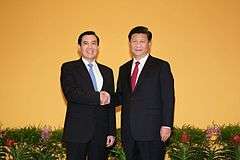
.svg.png)
.svg.png)